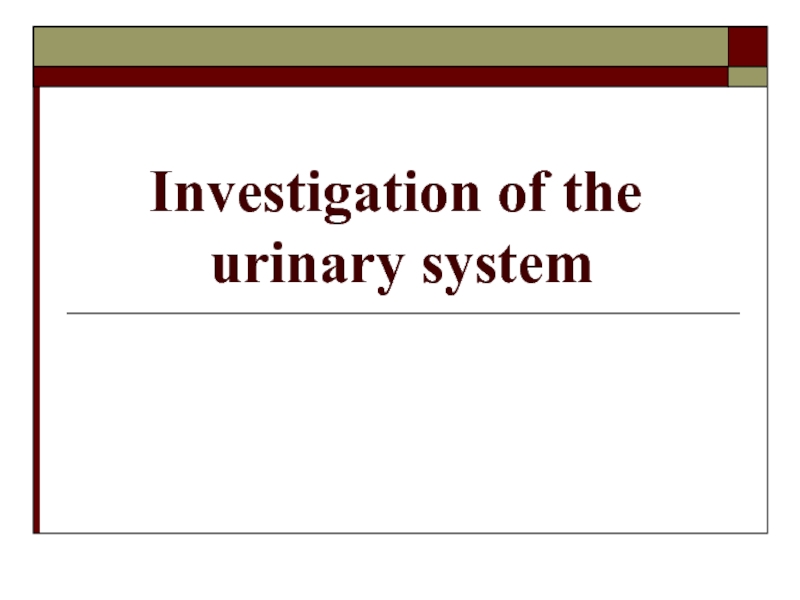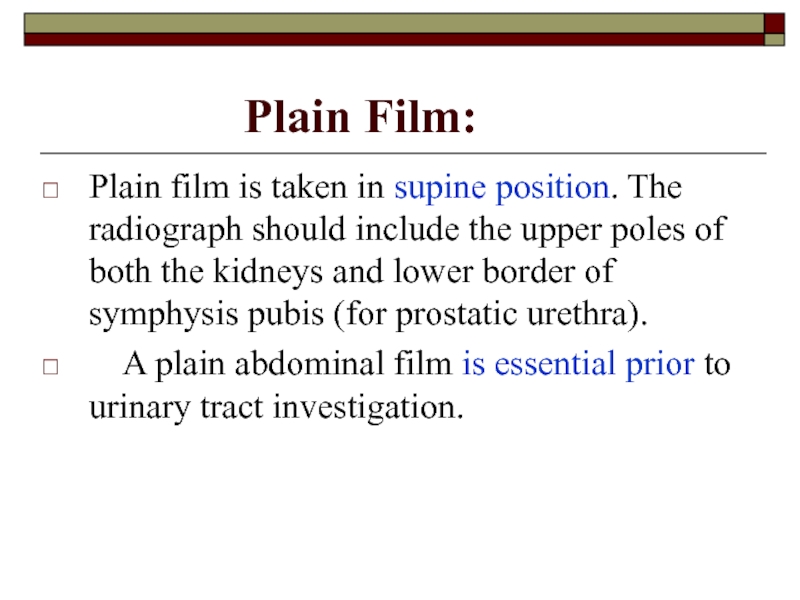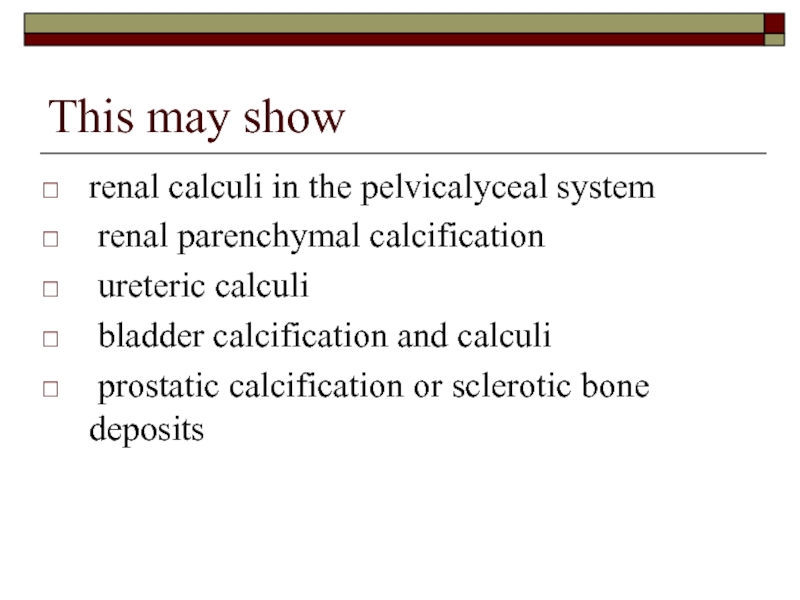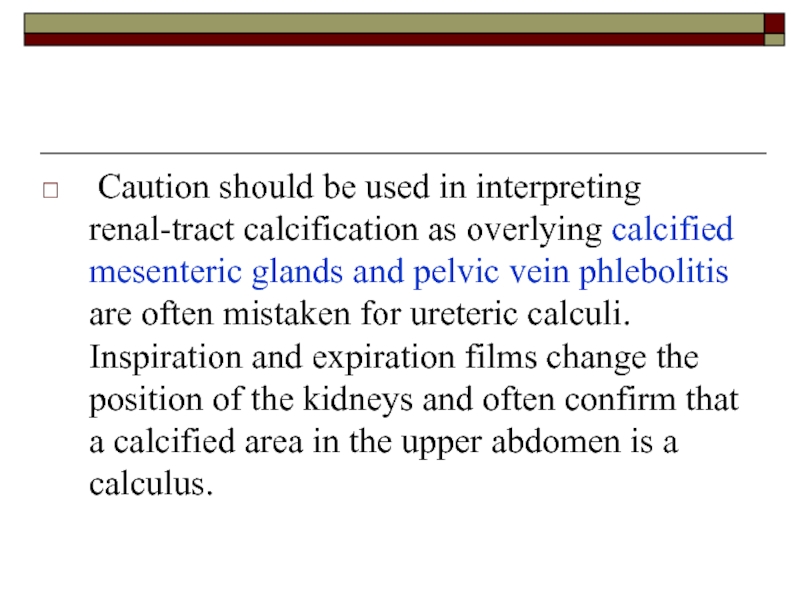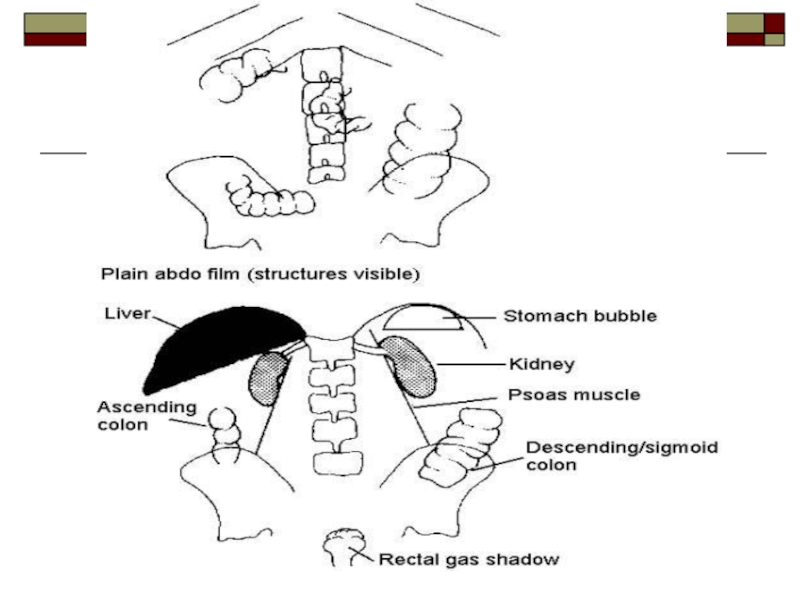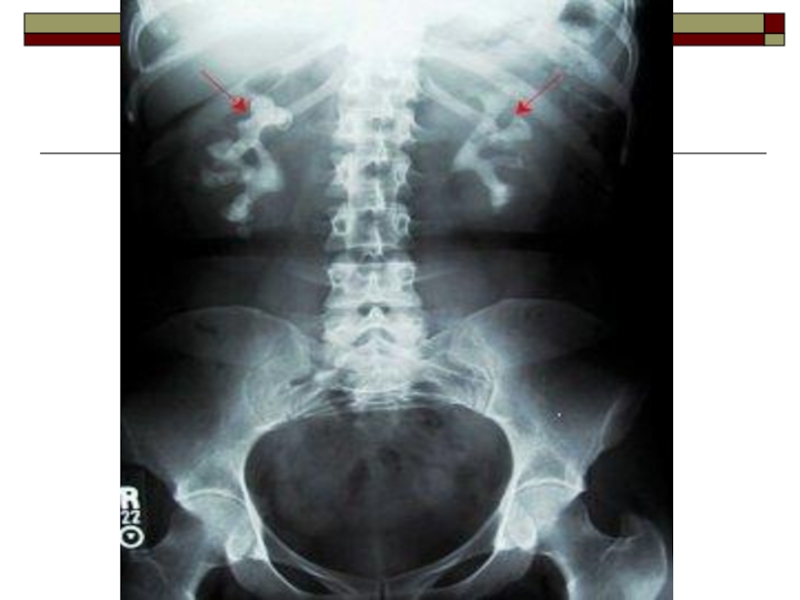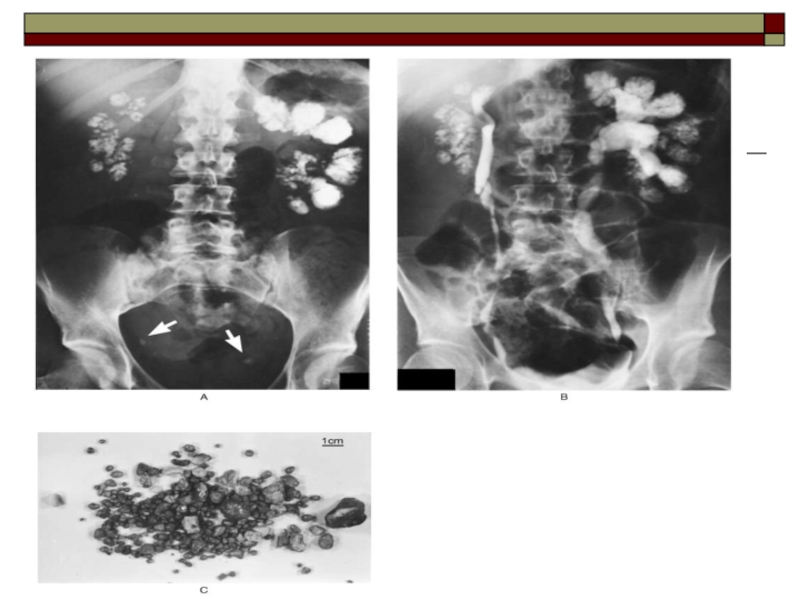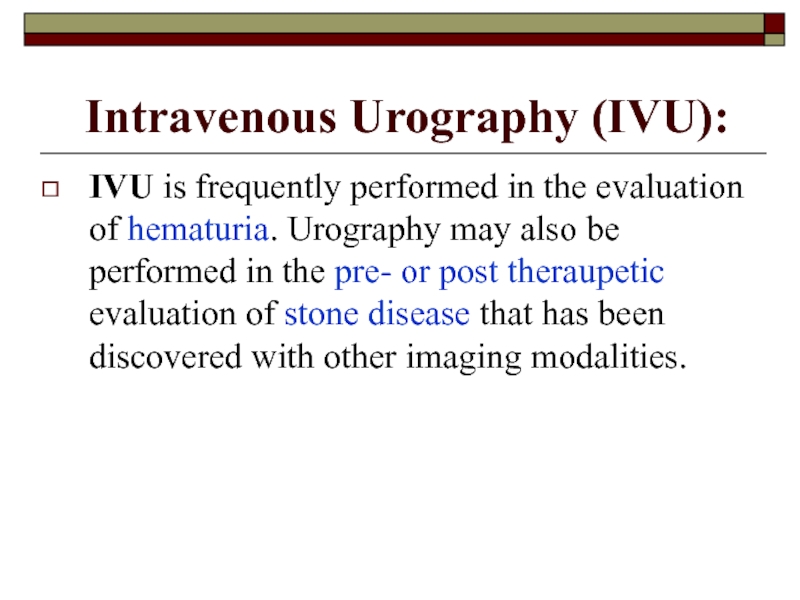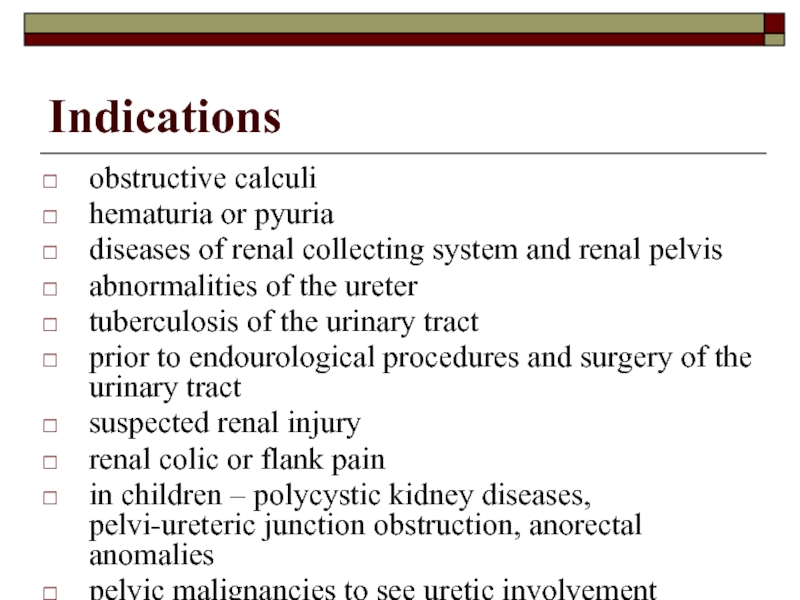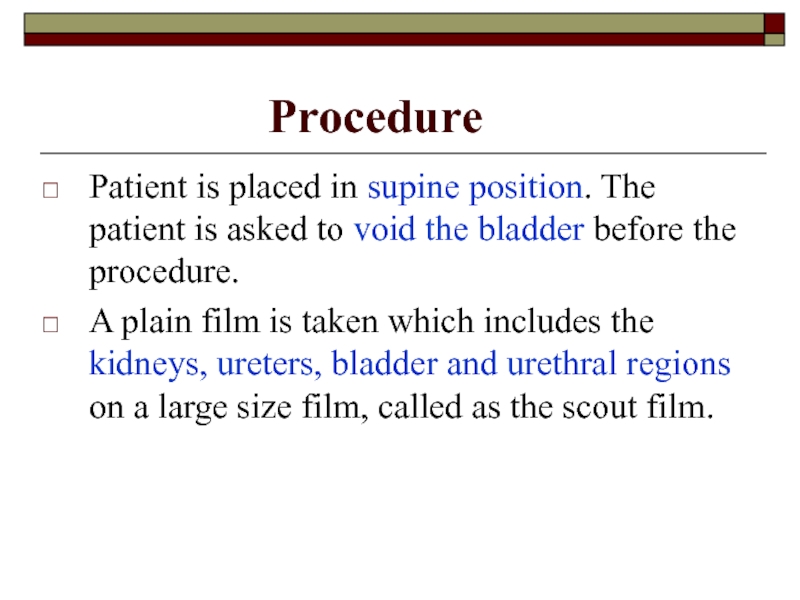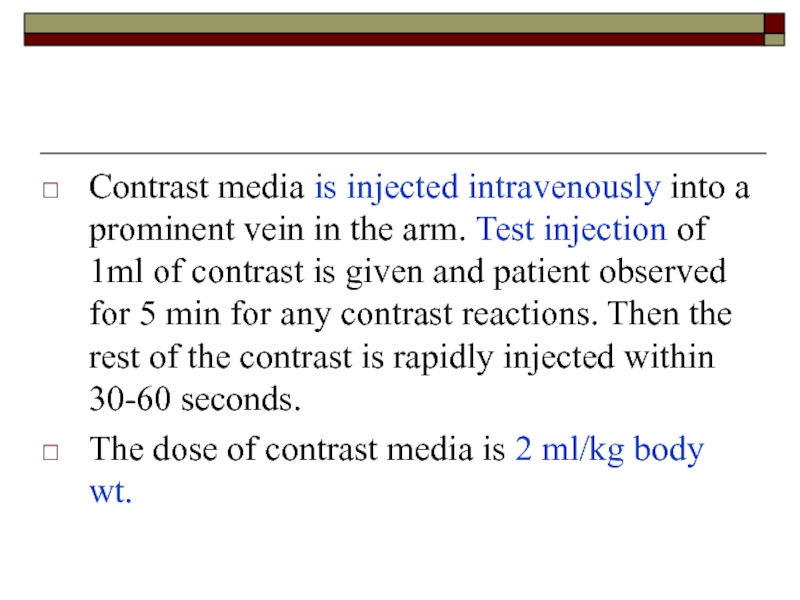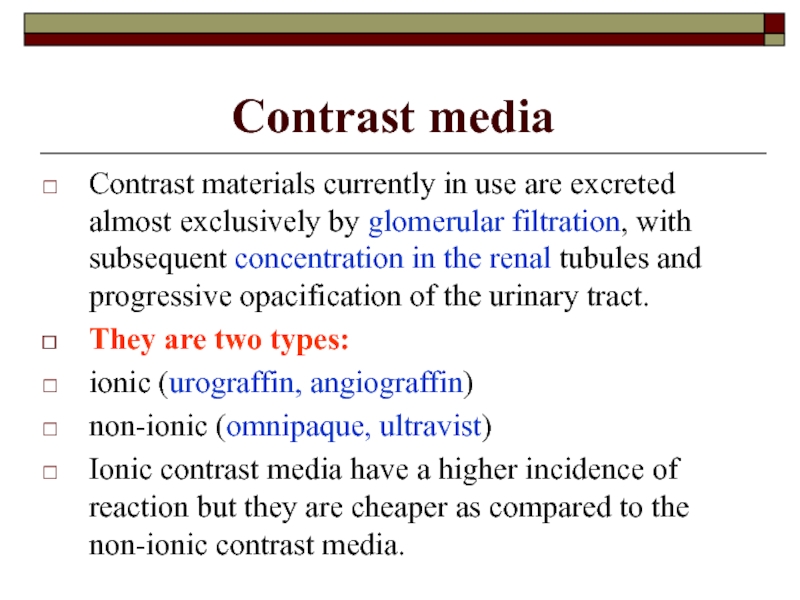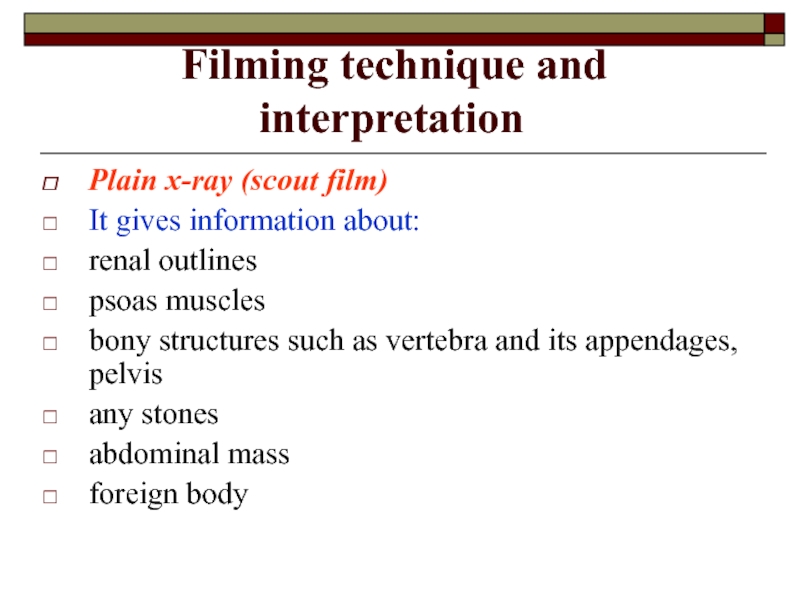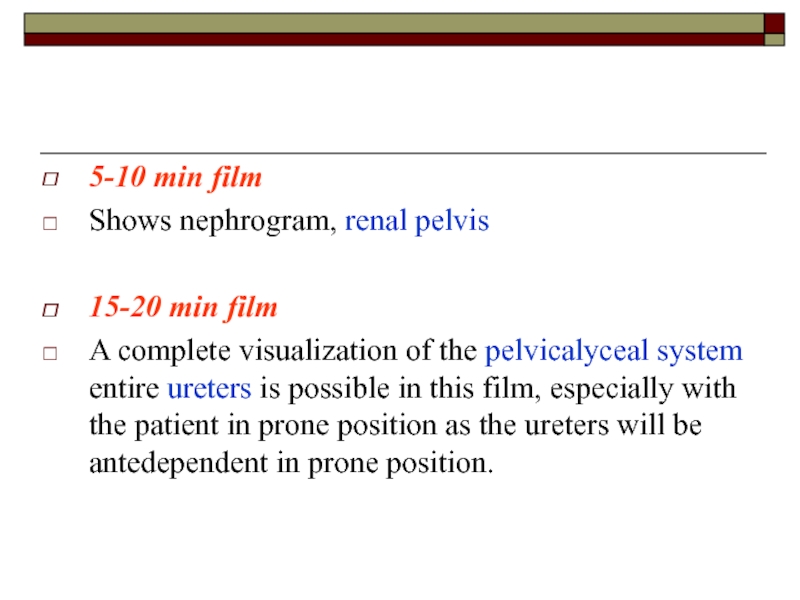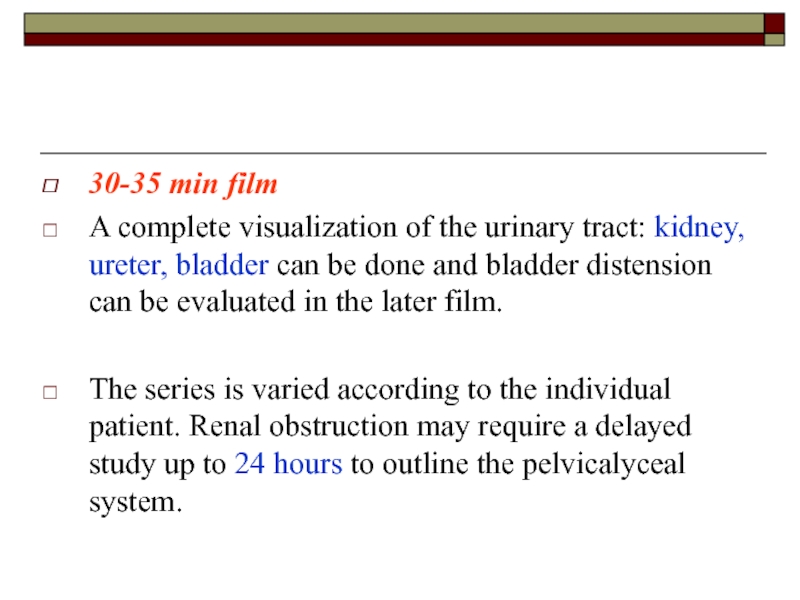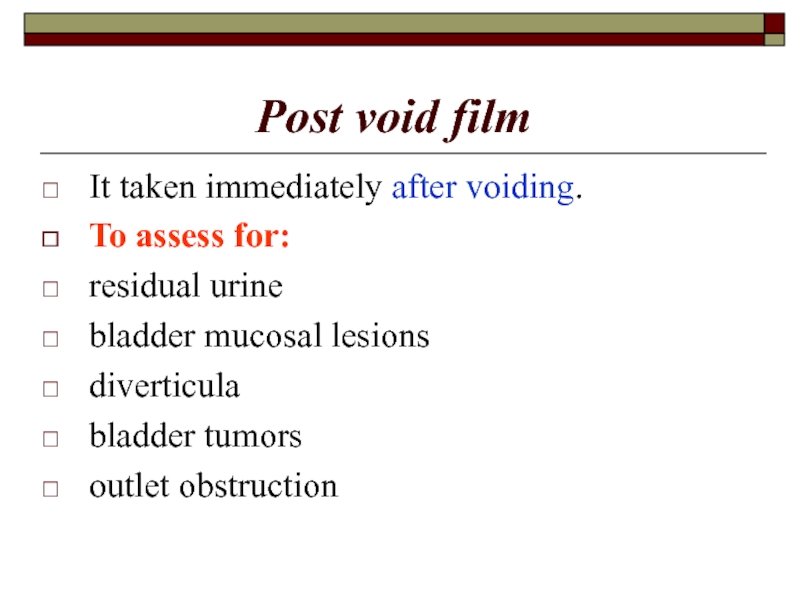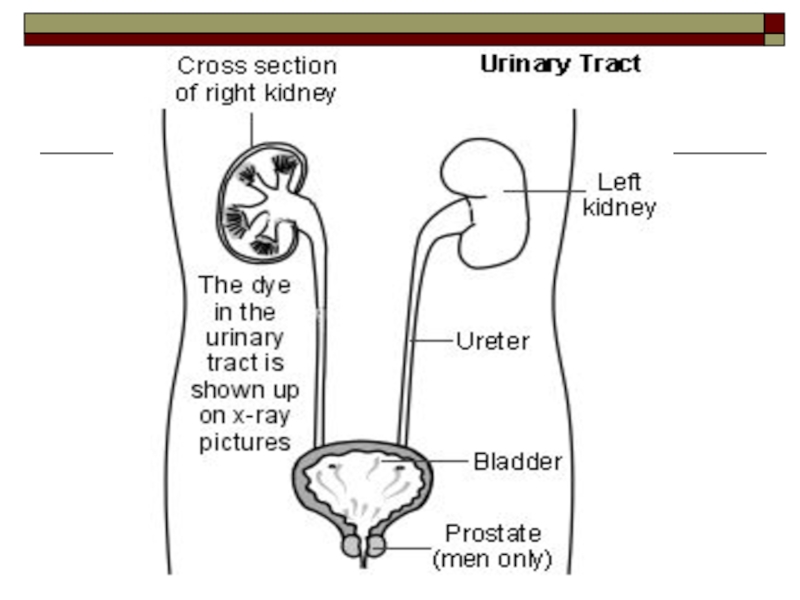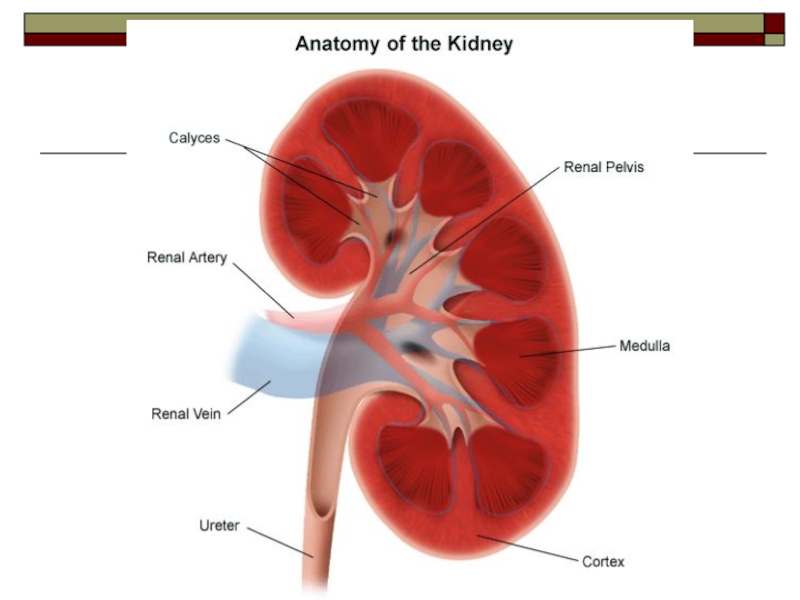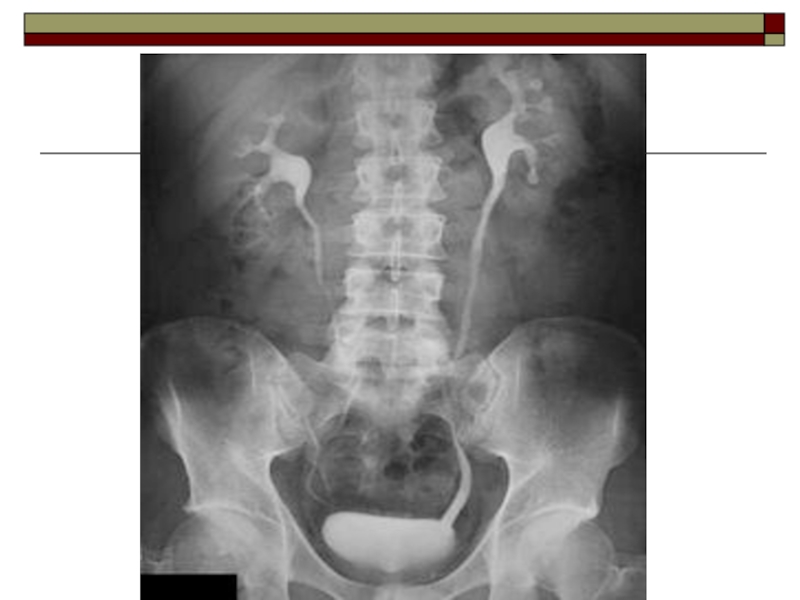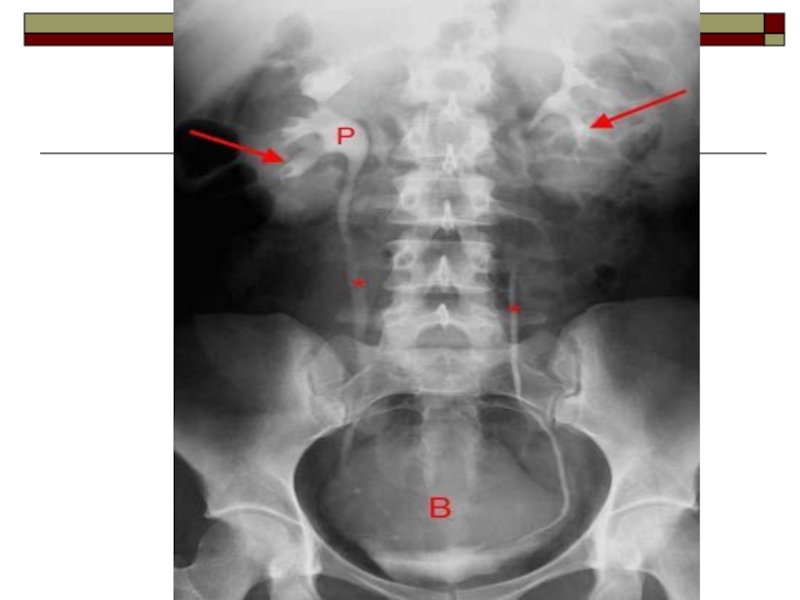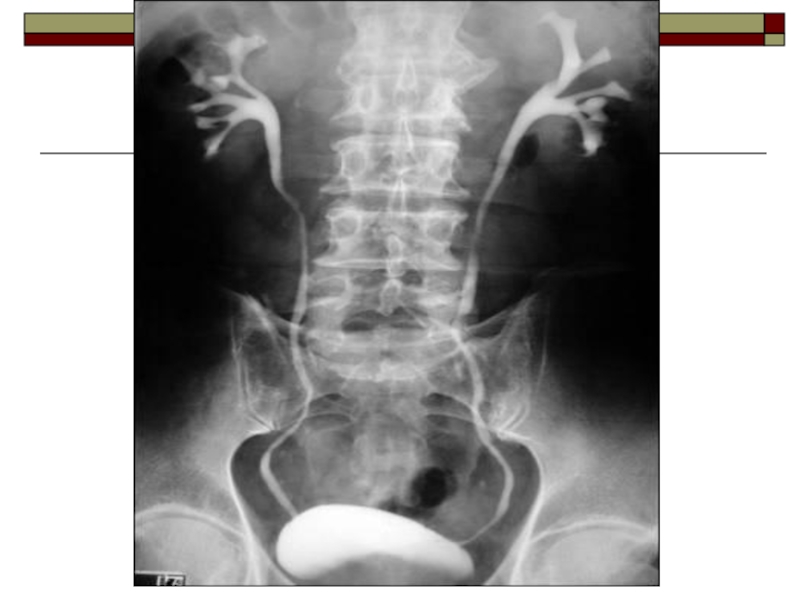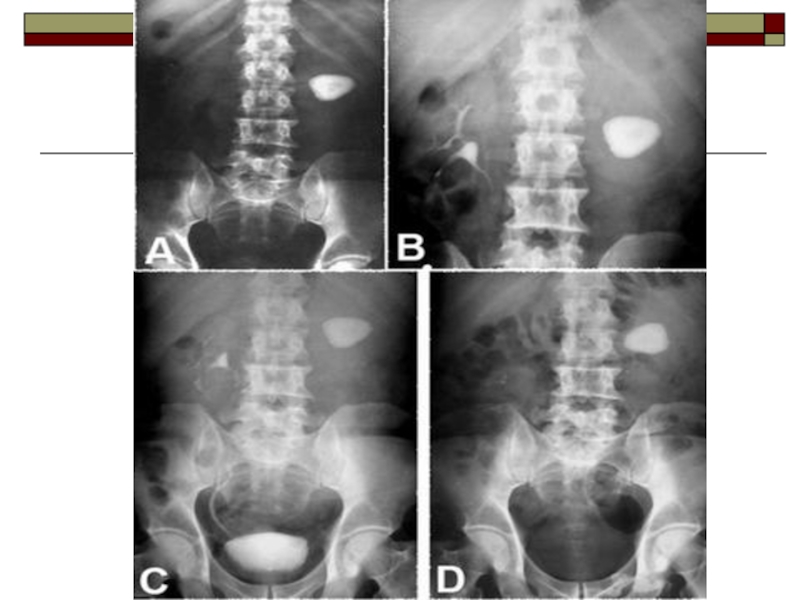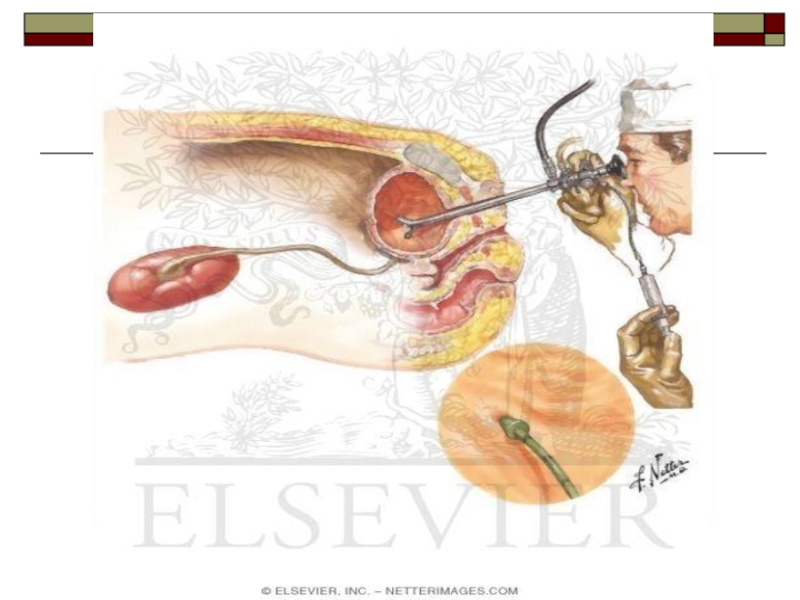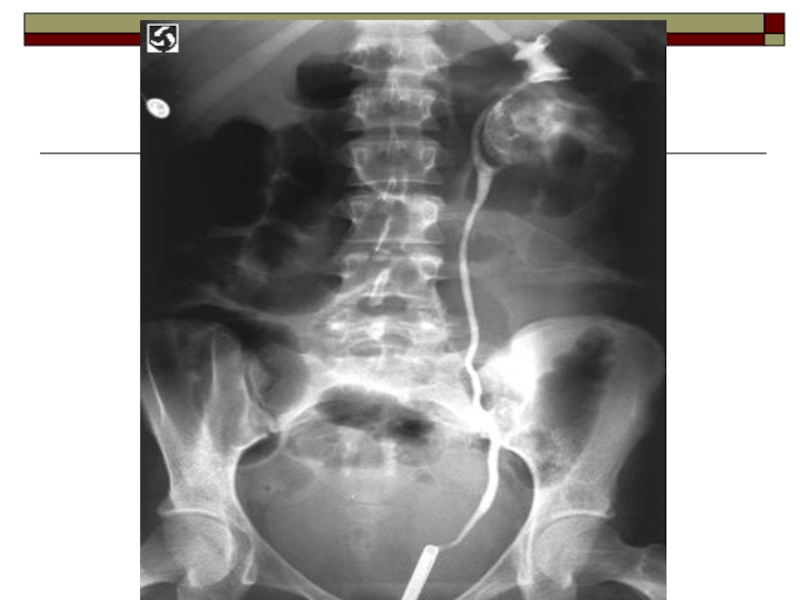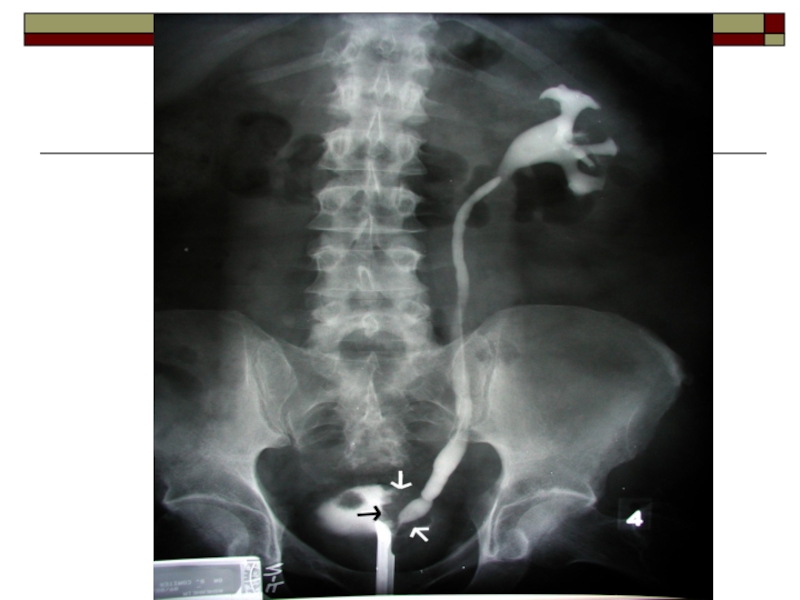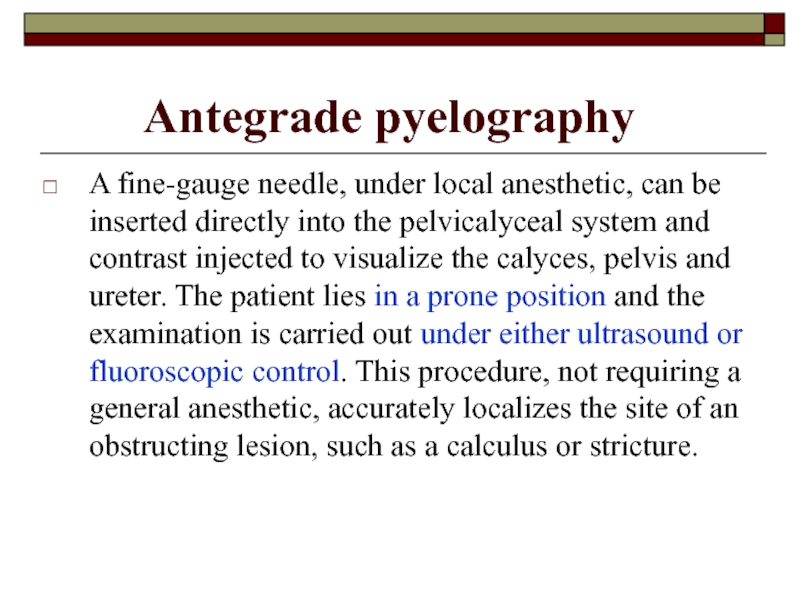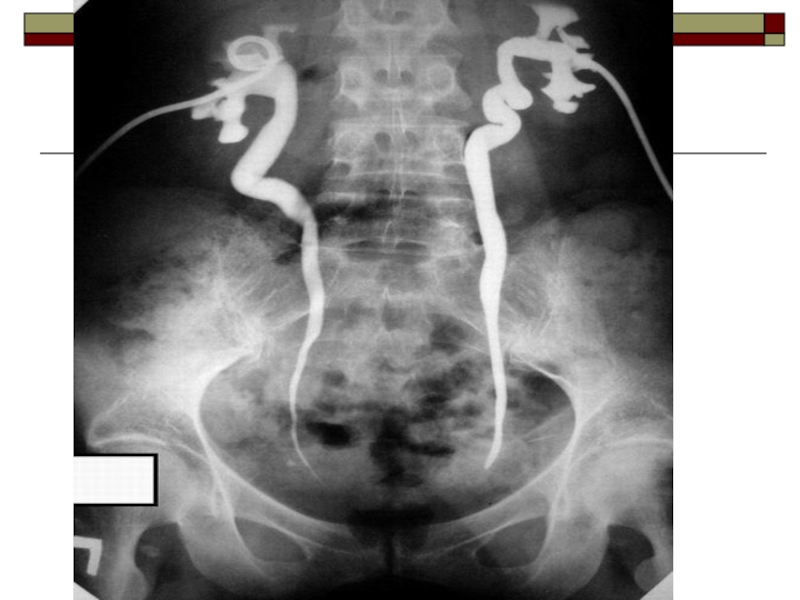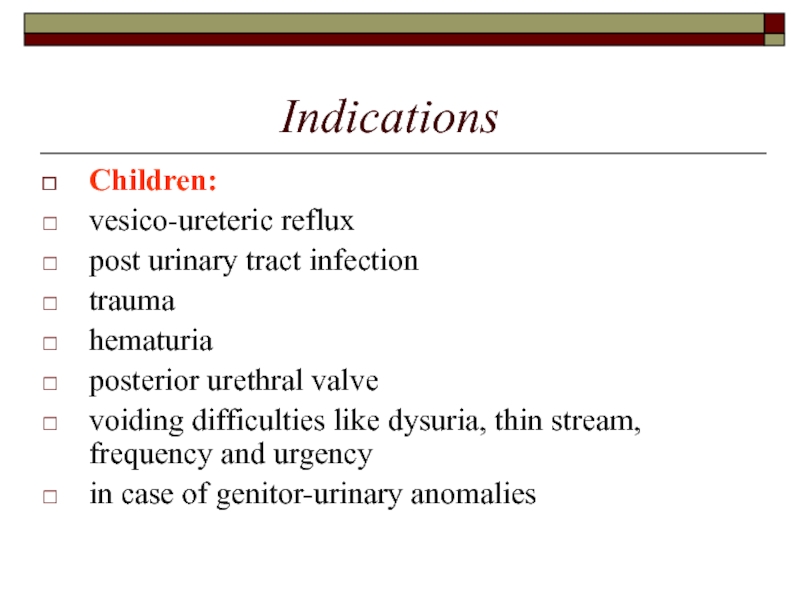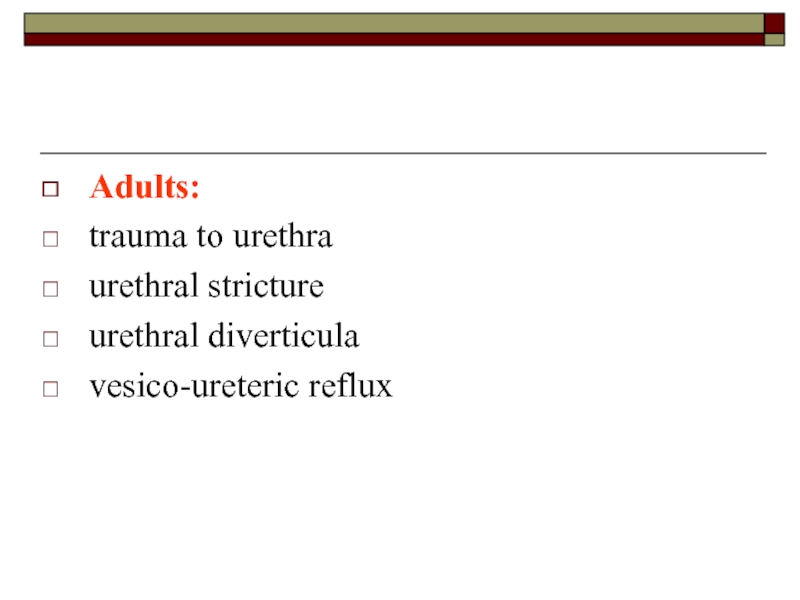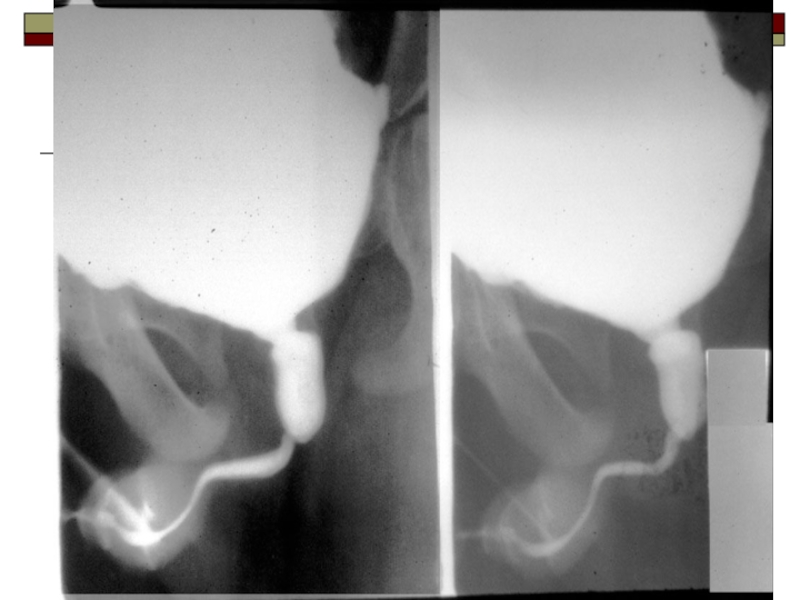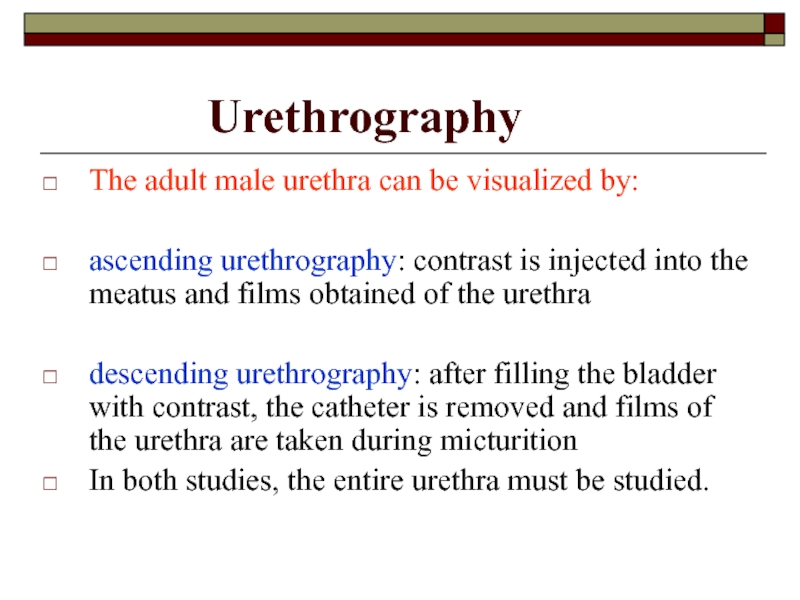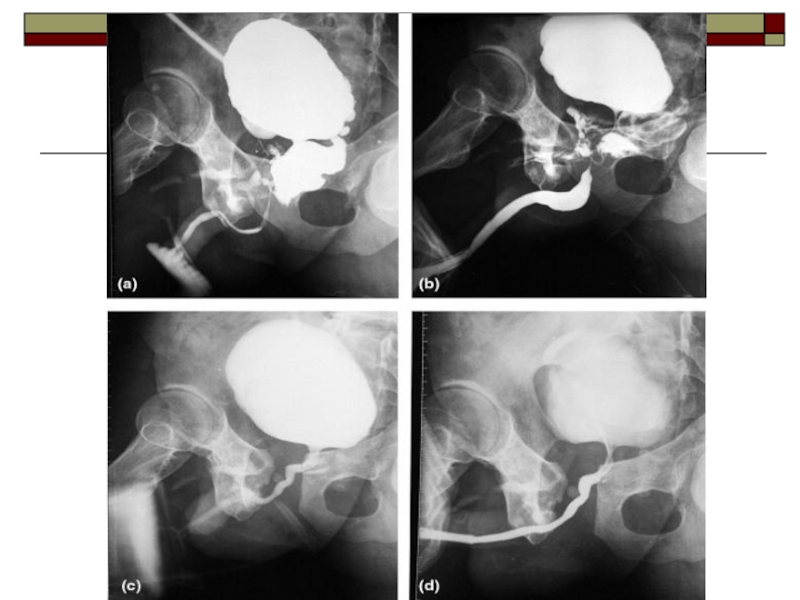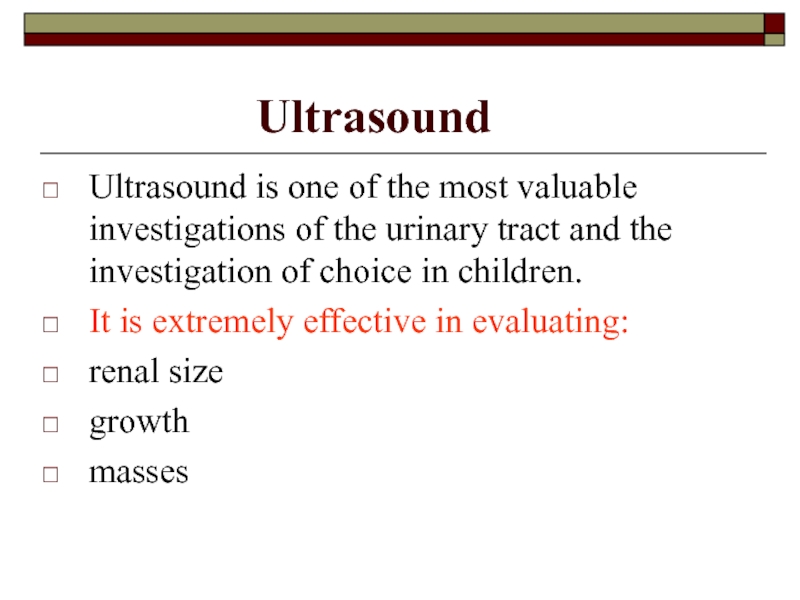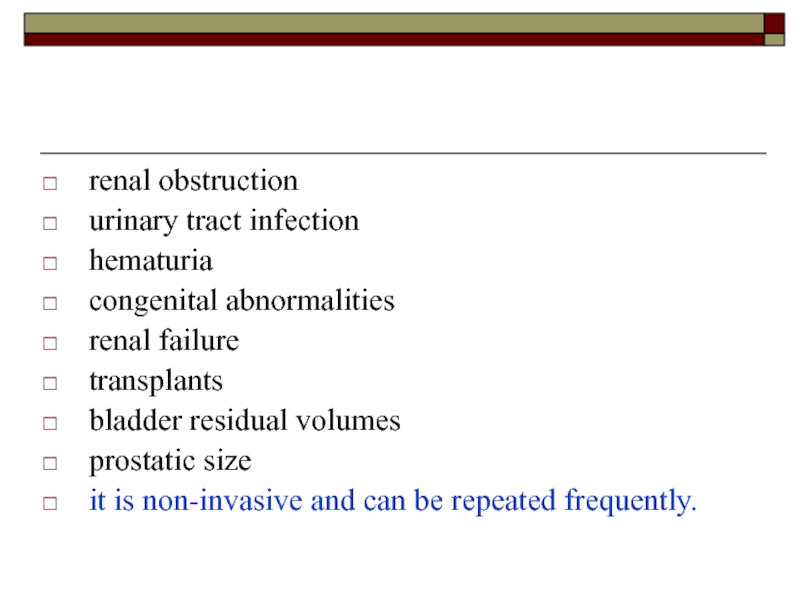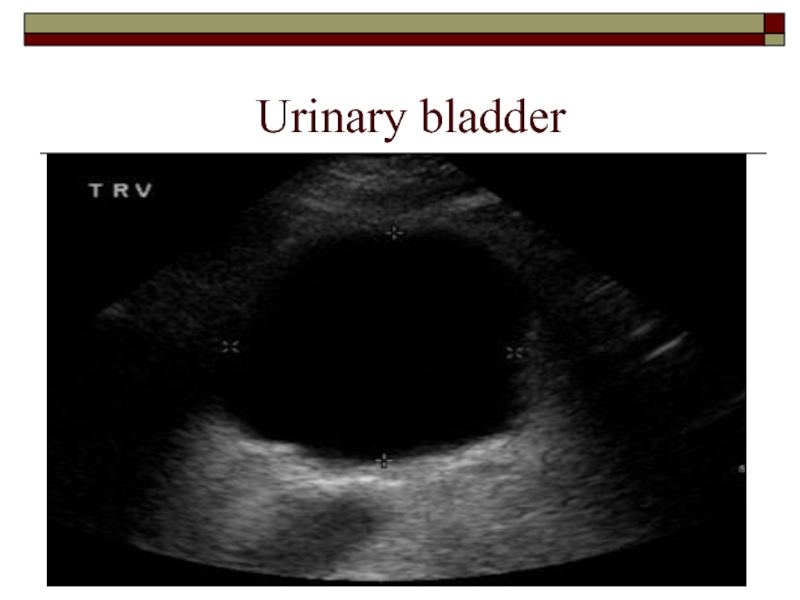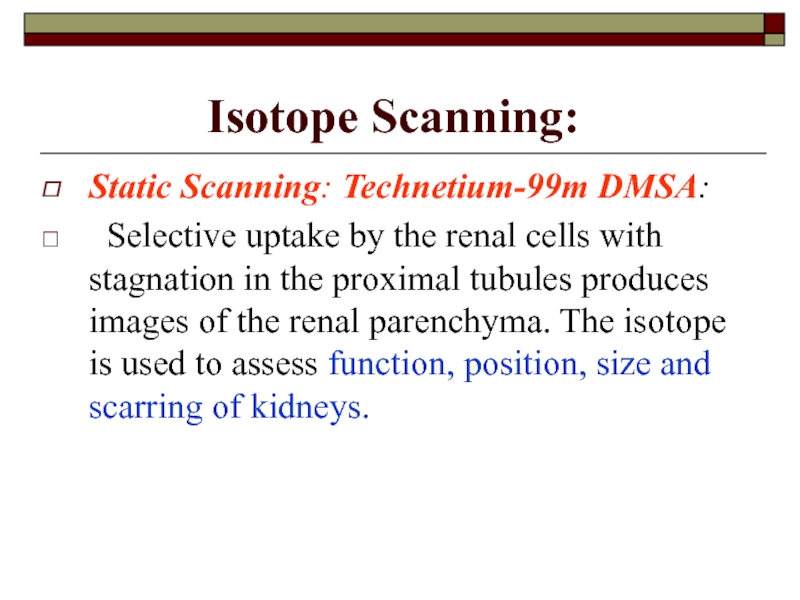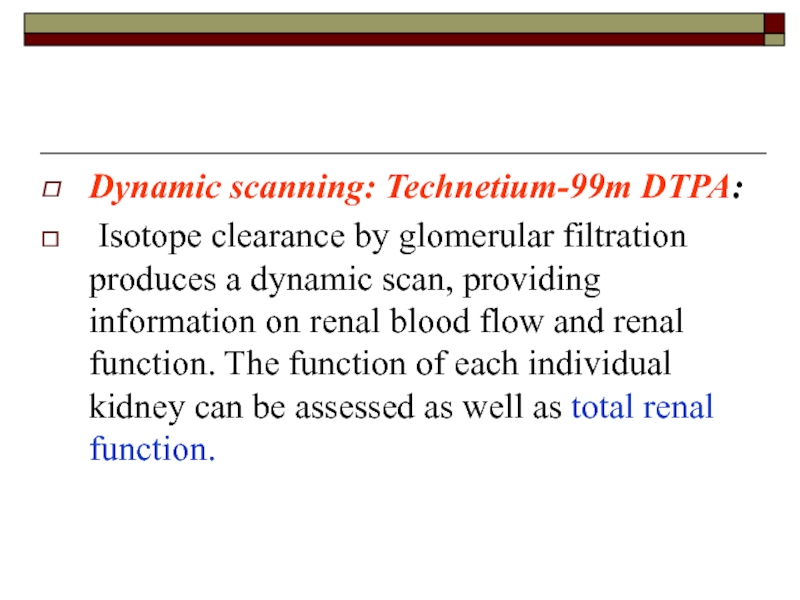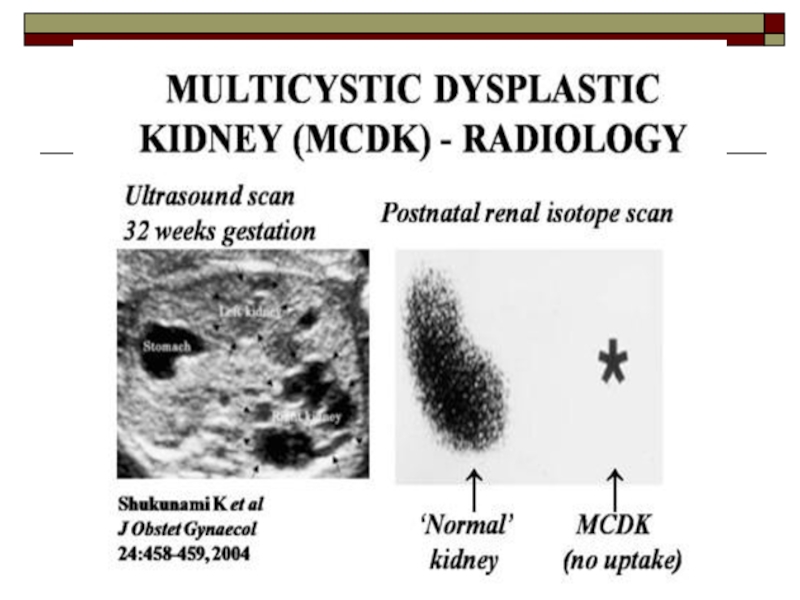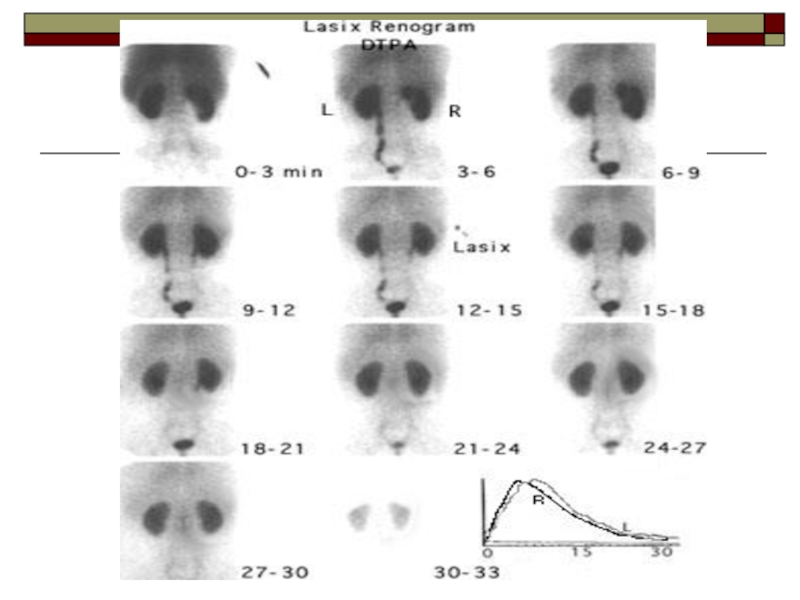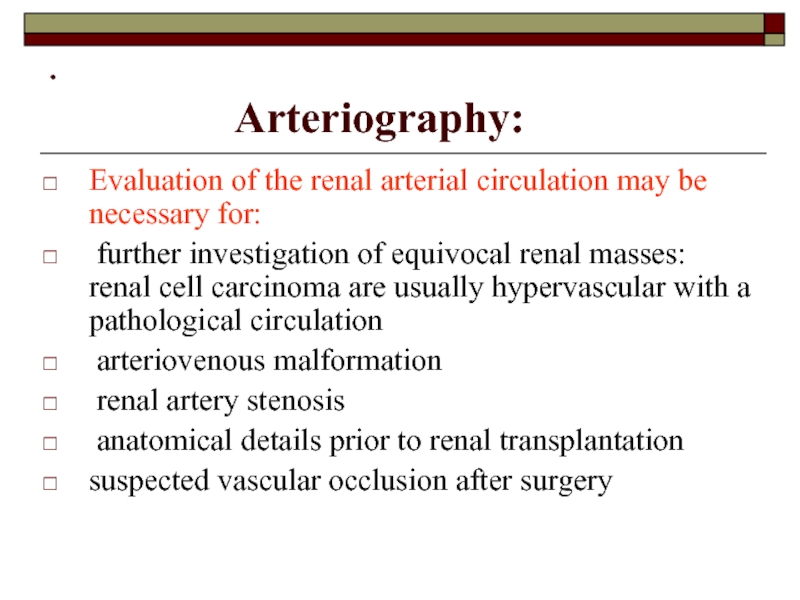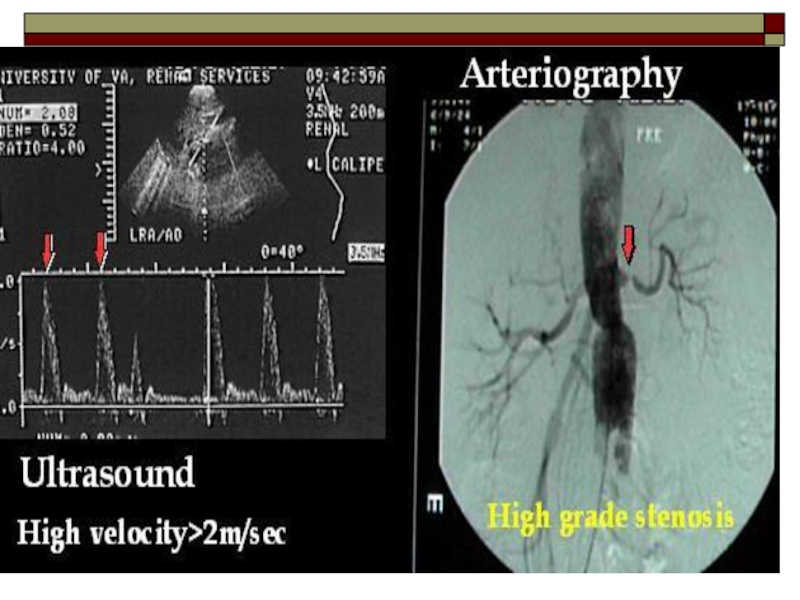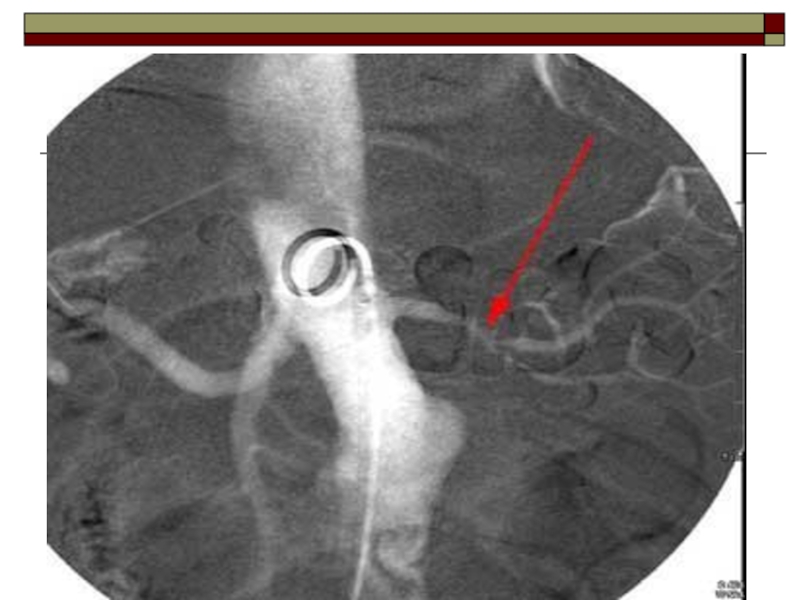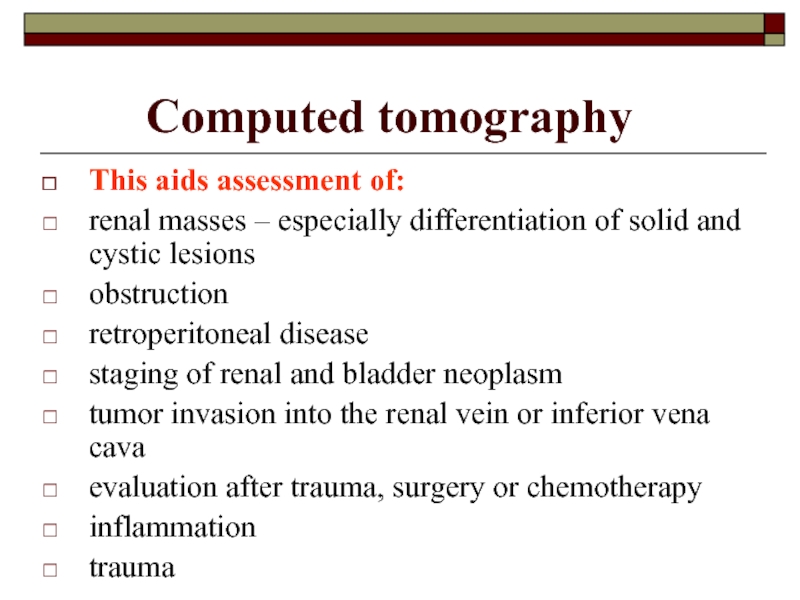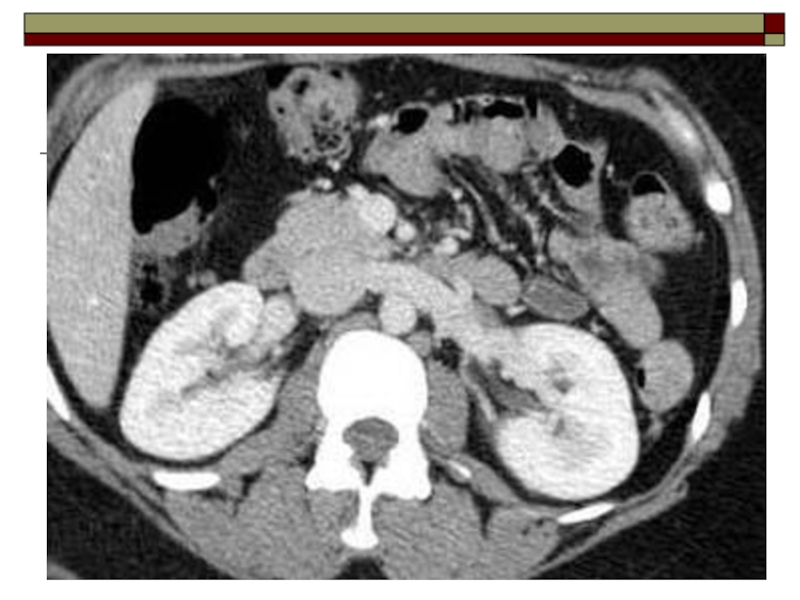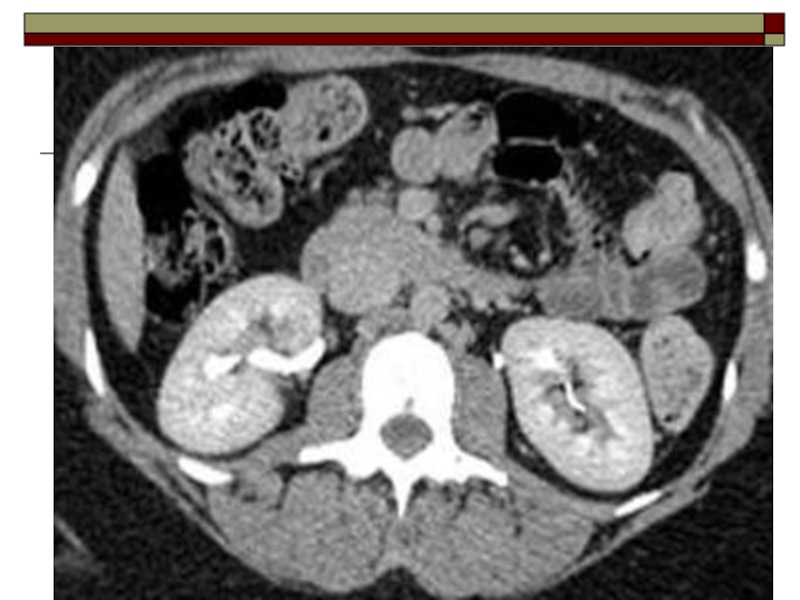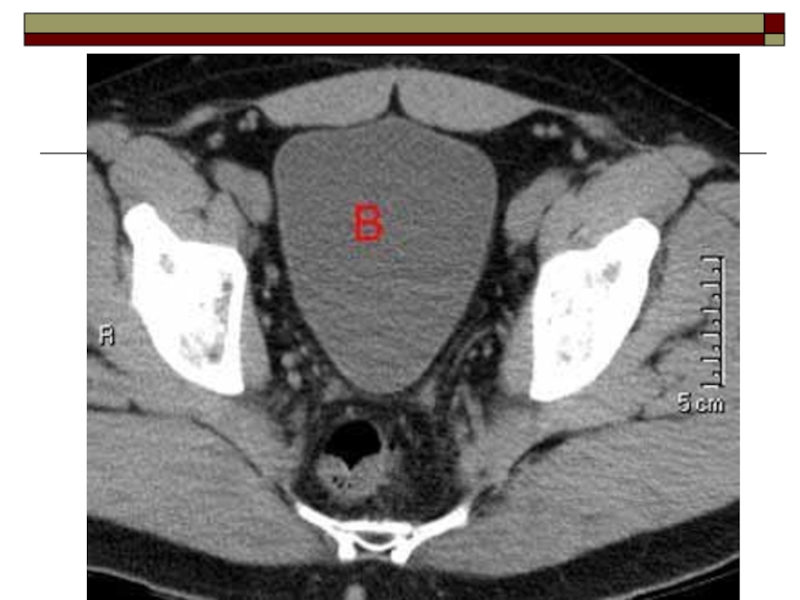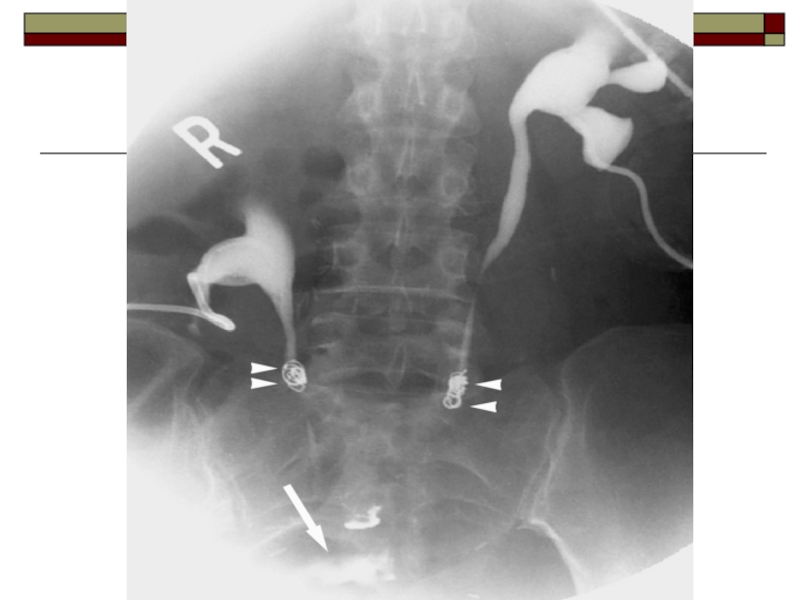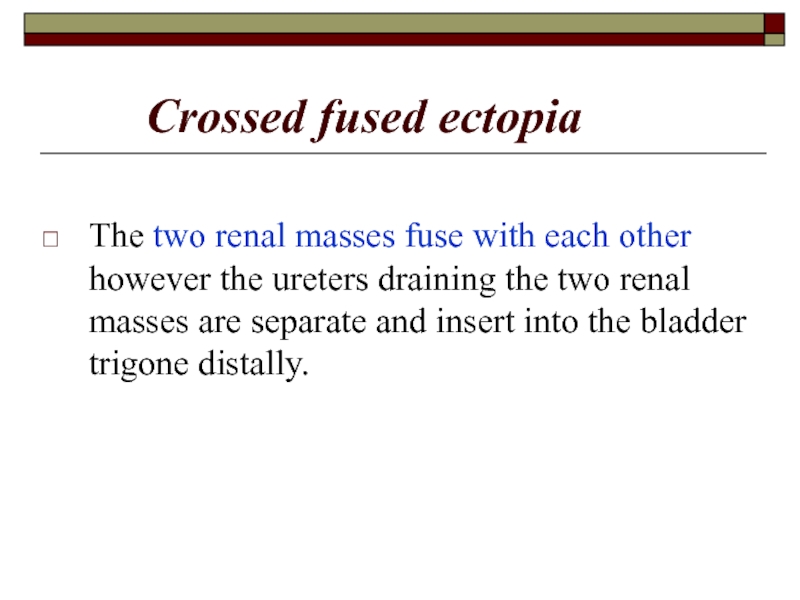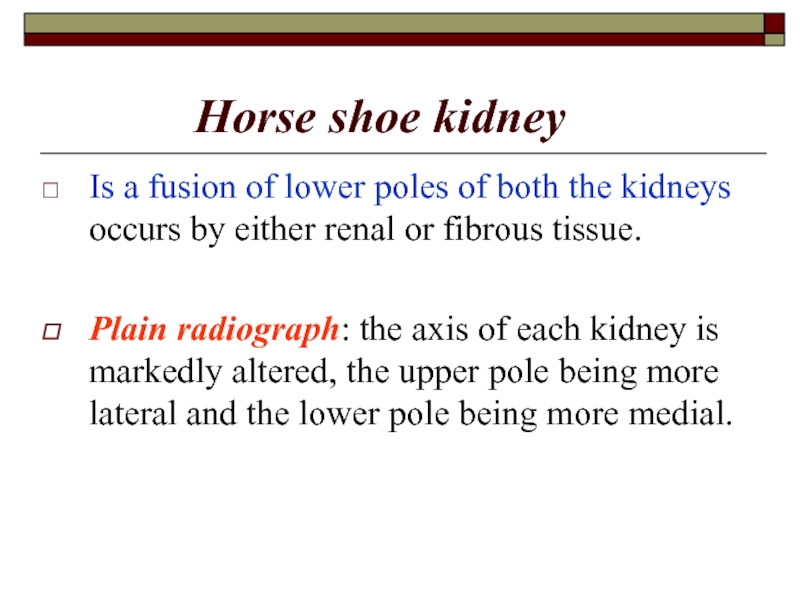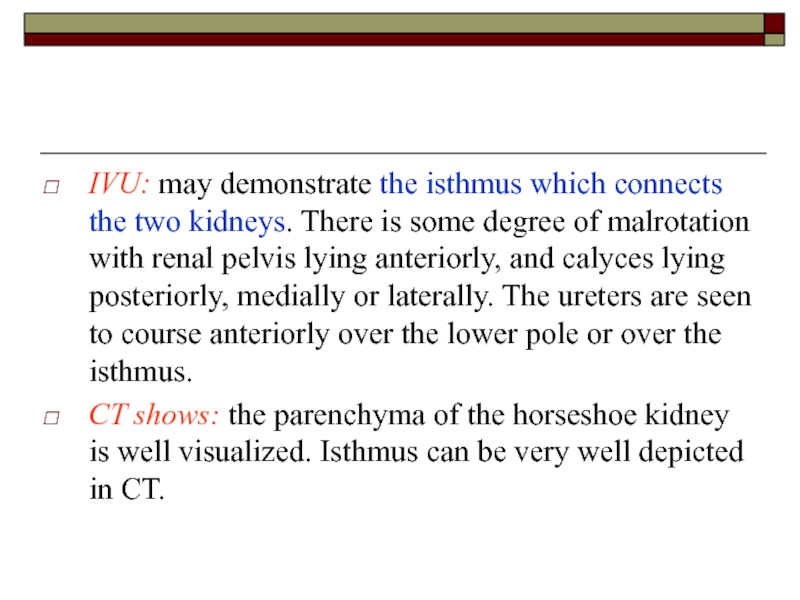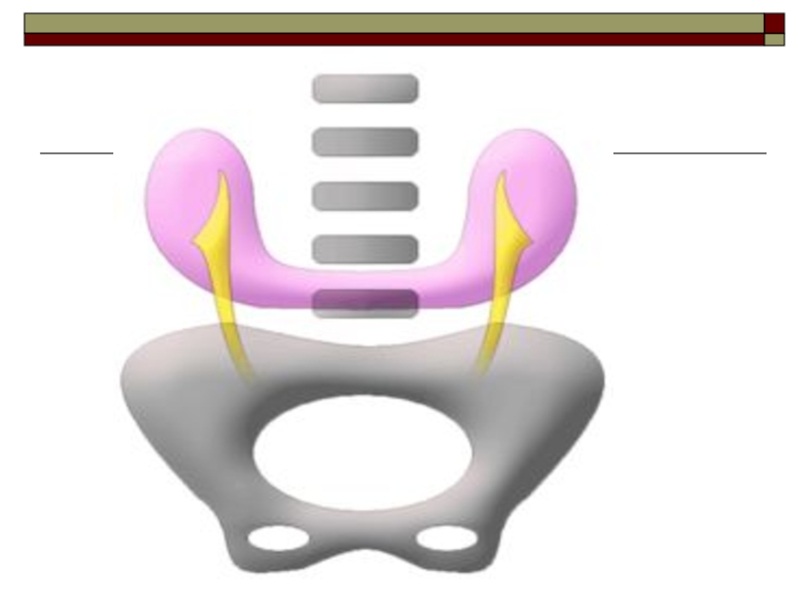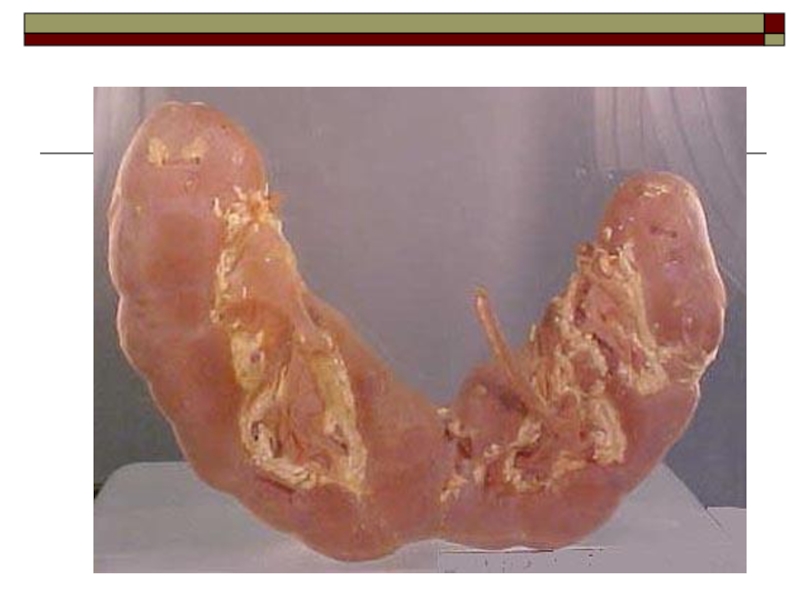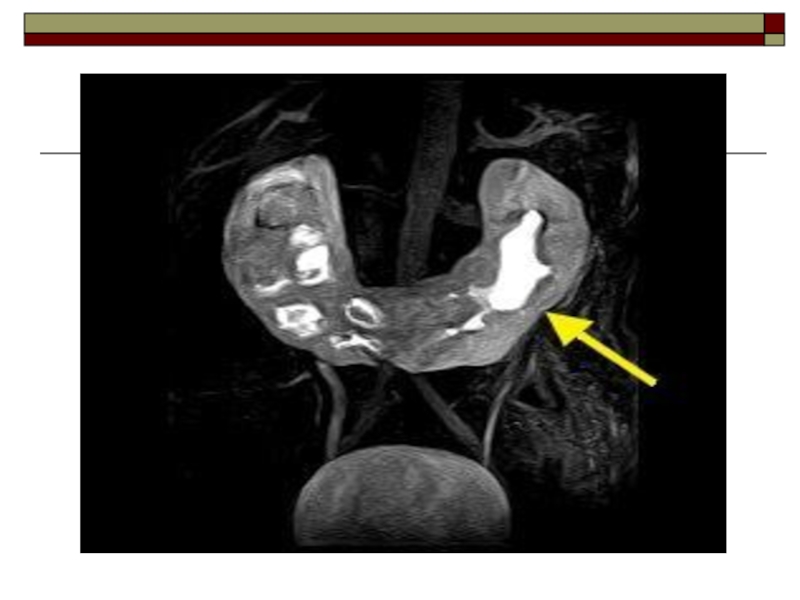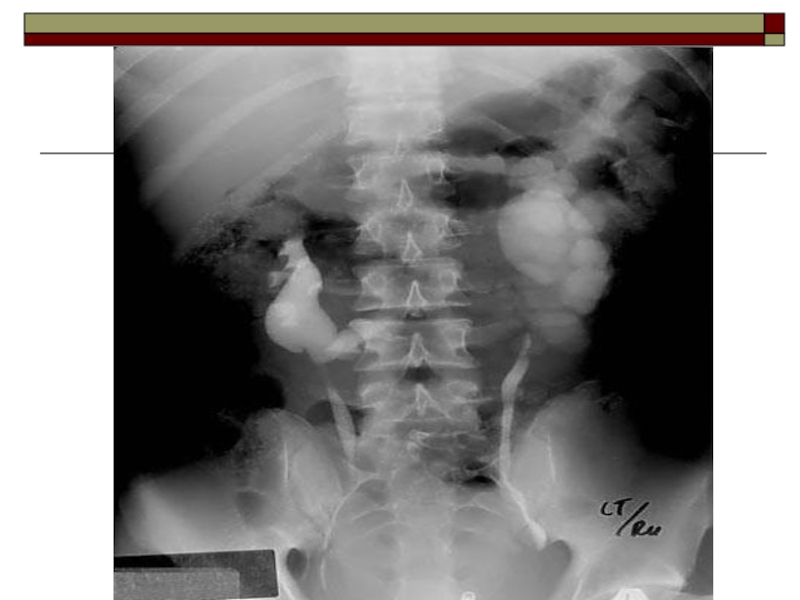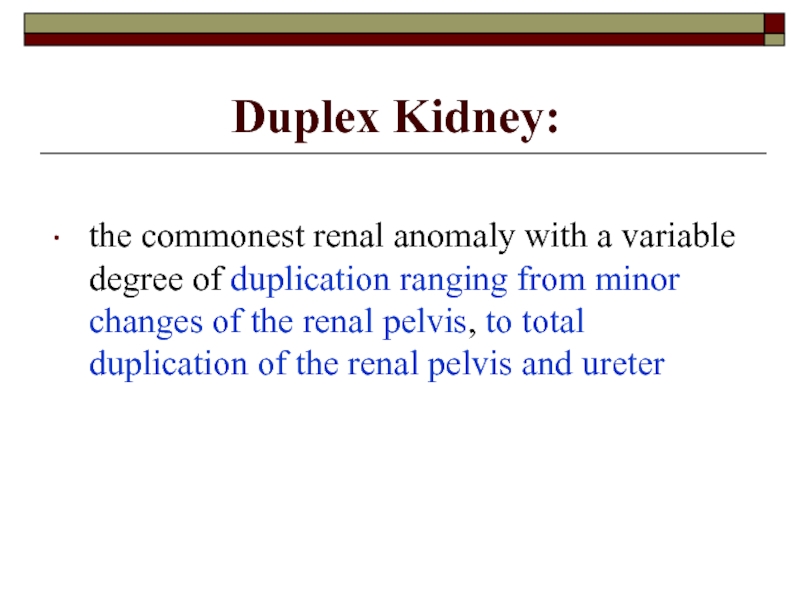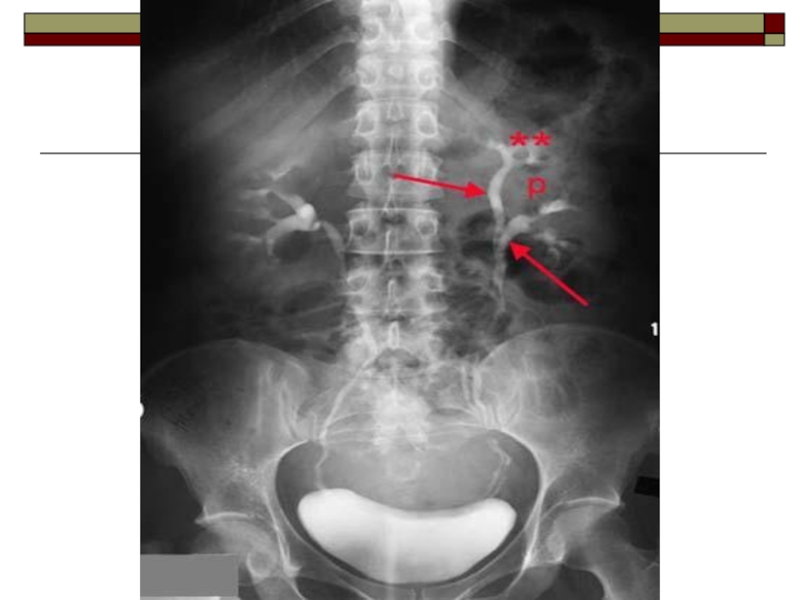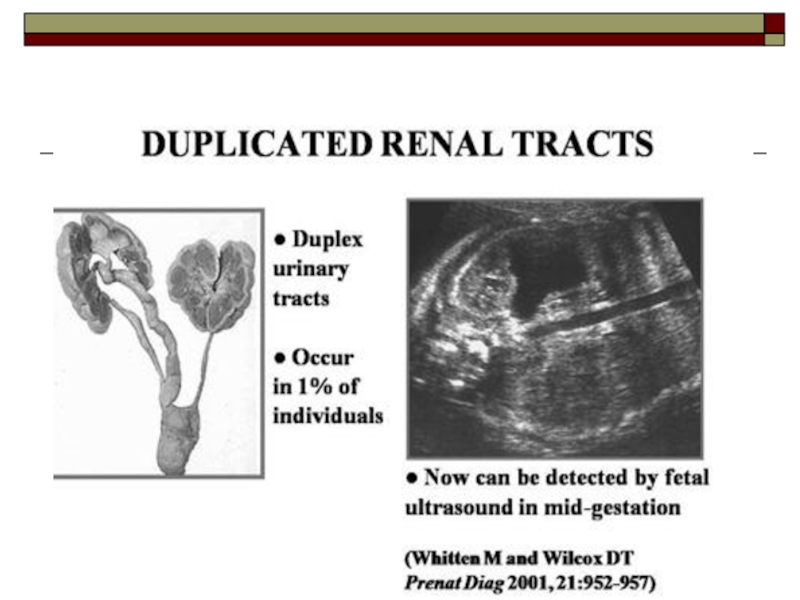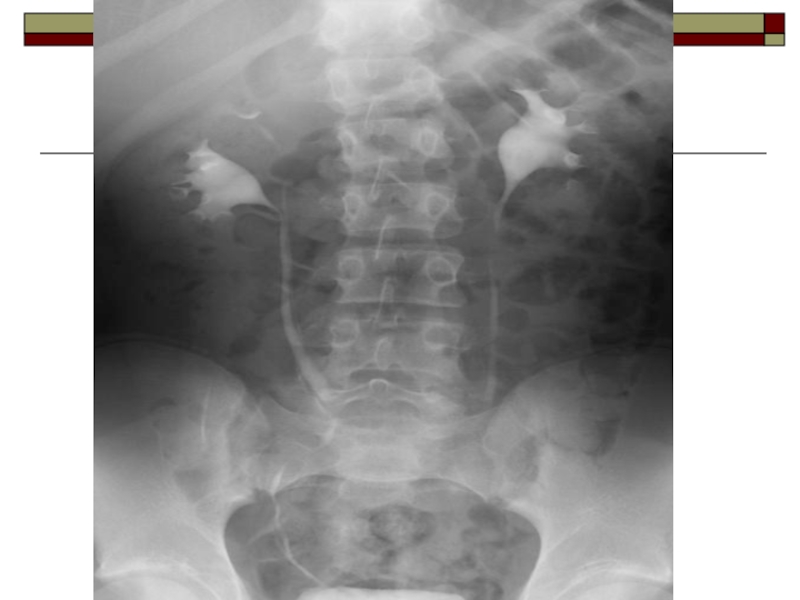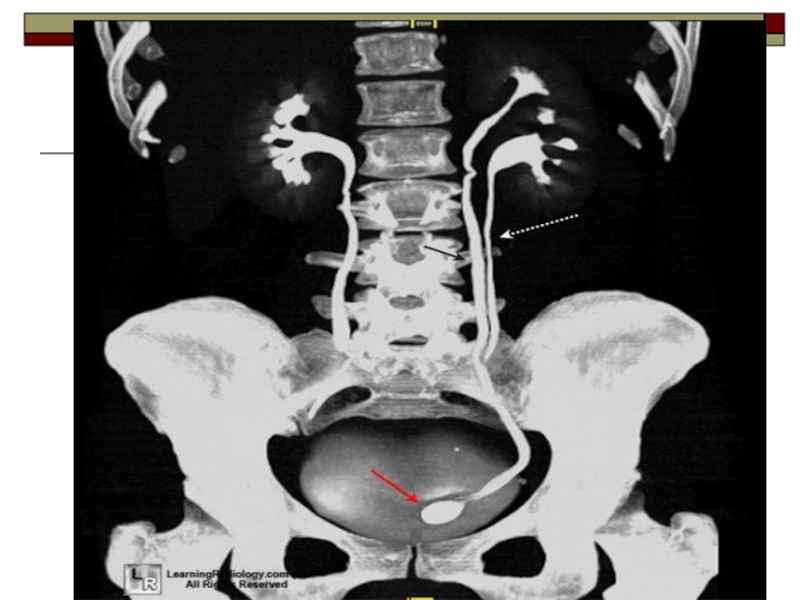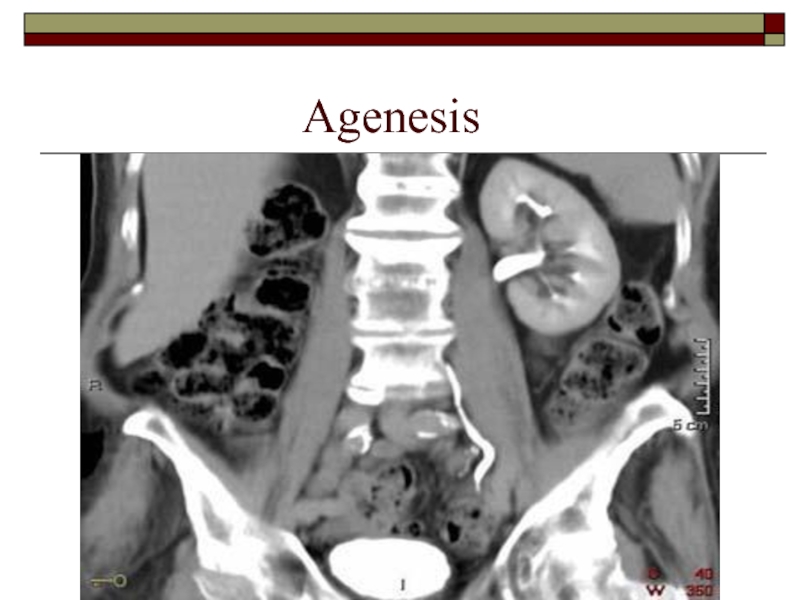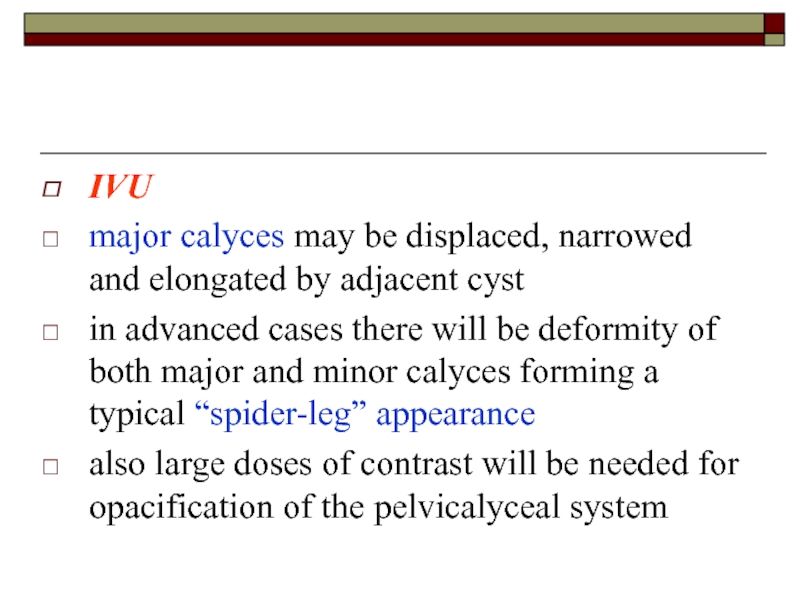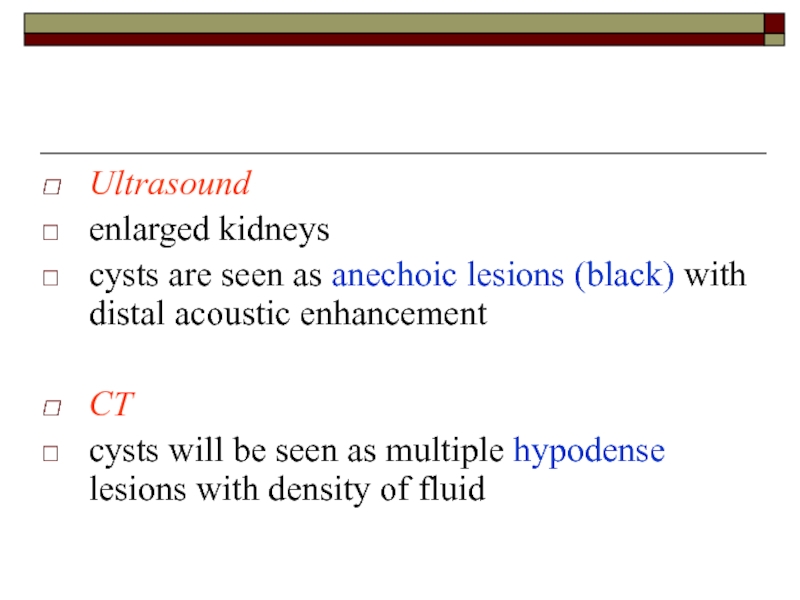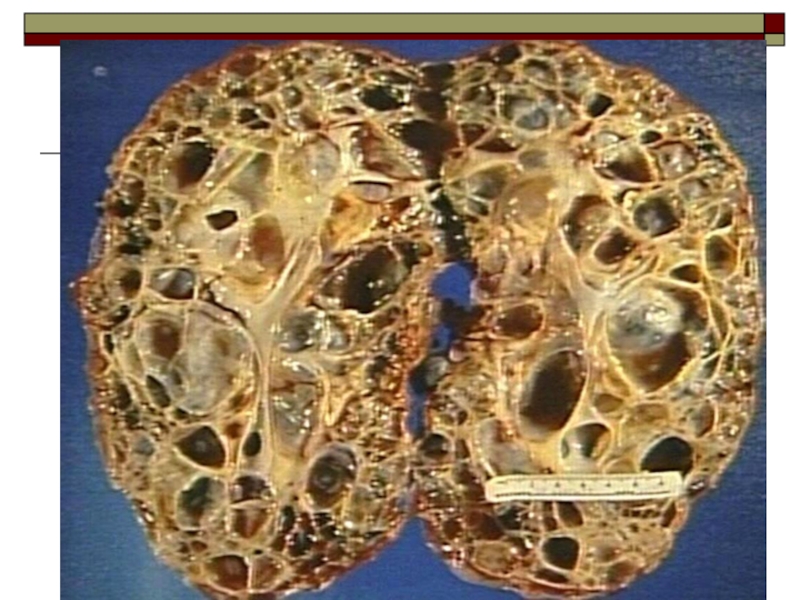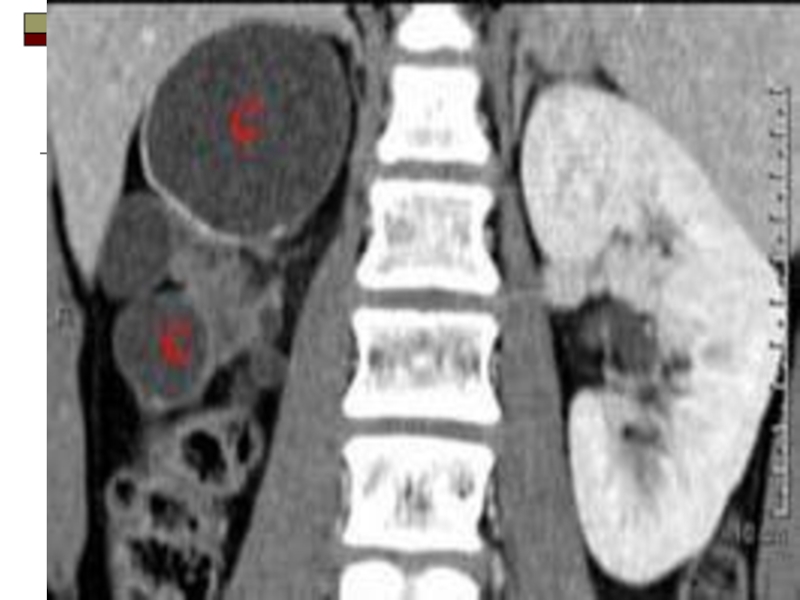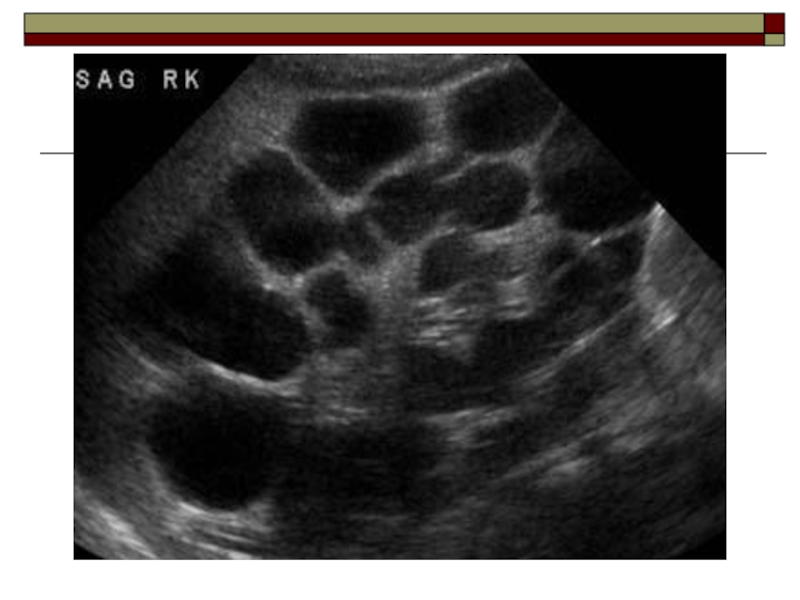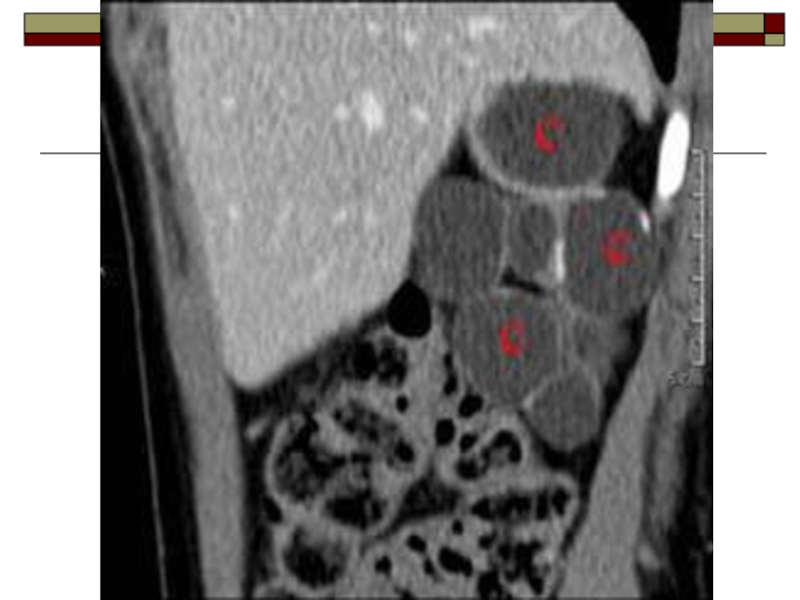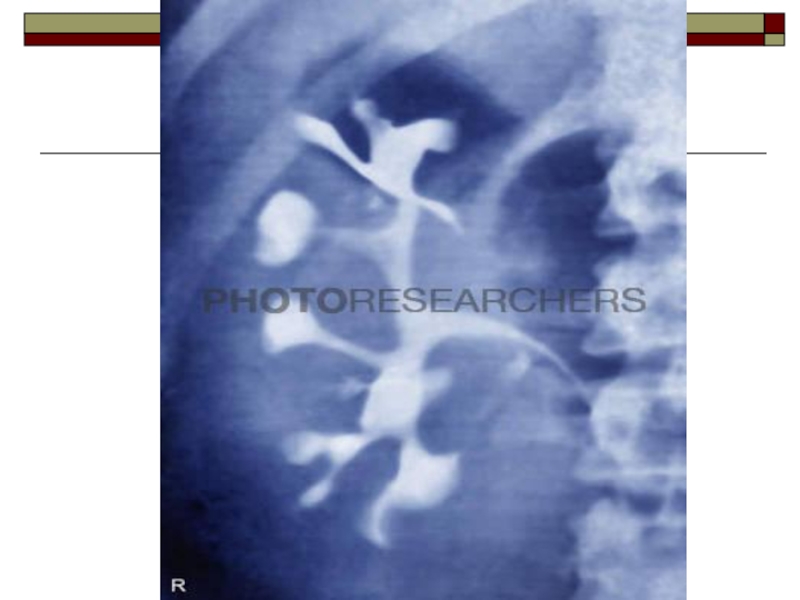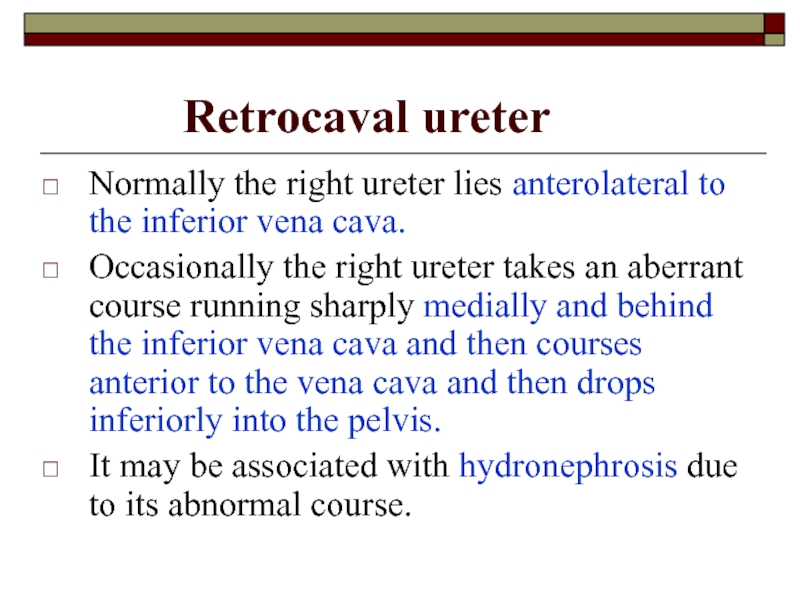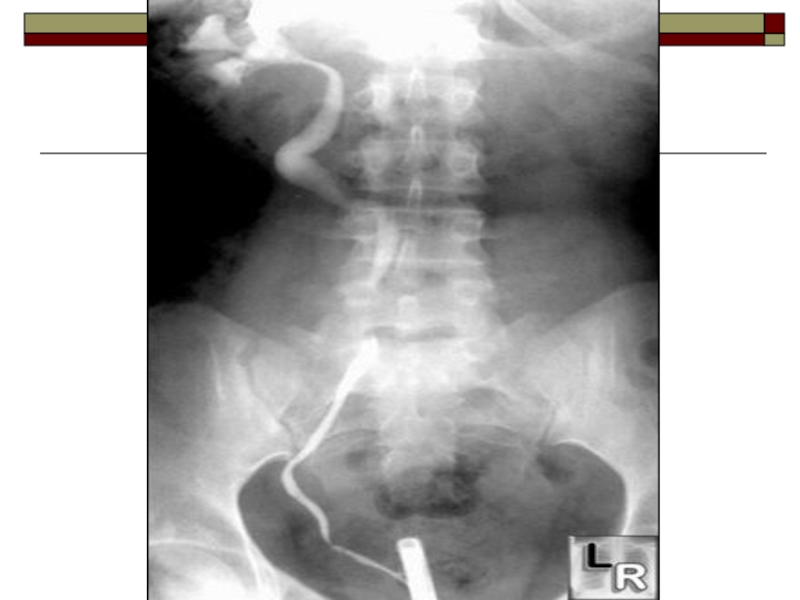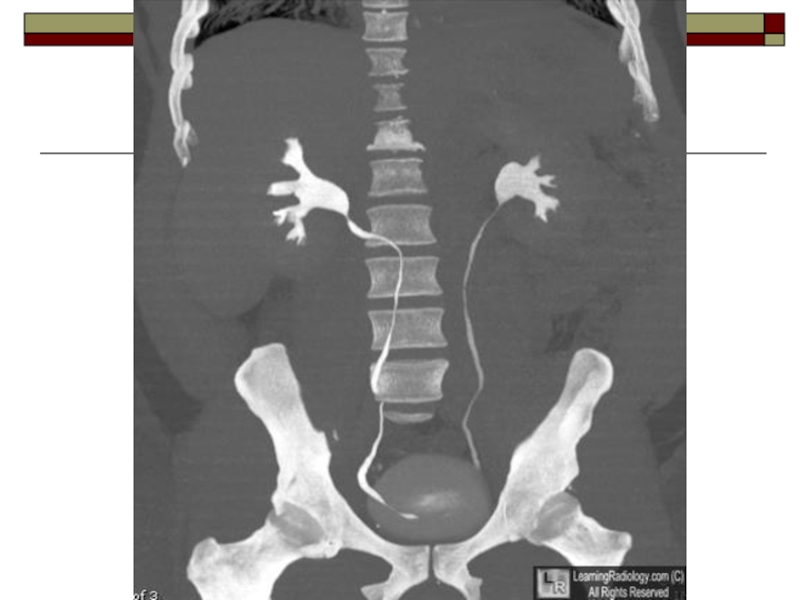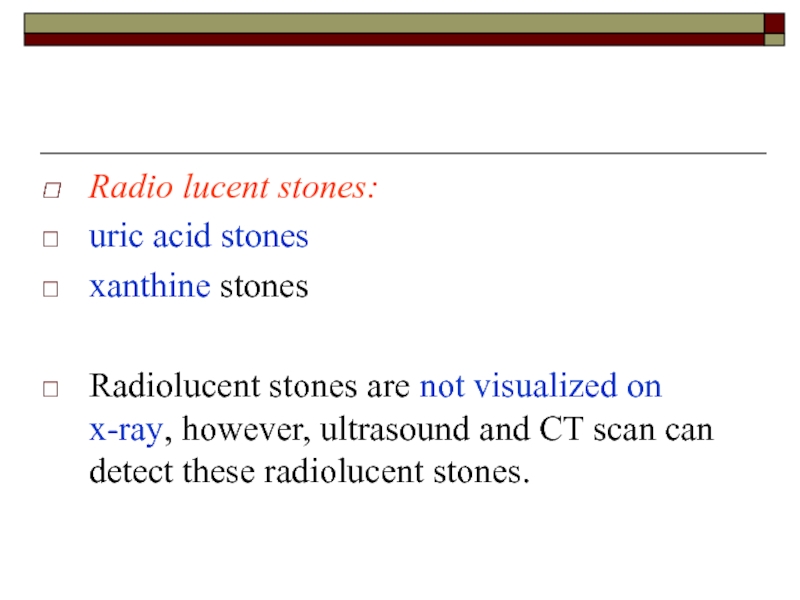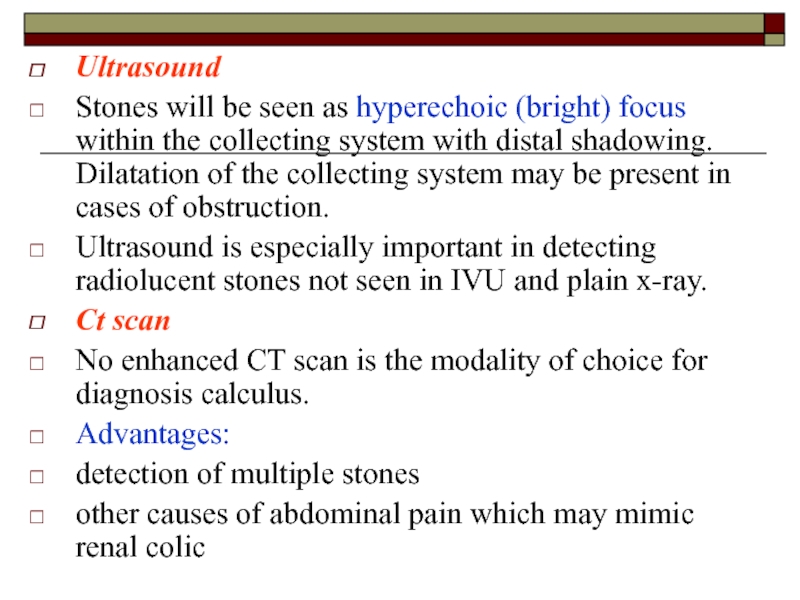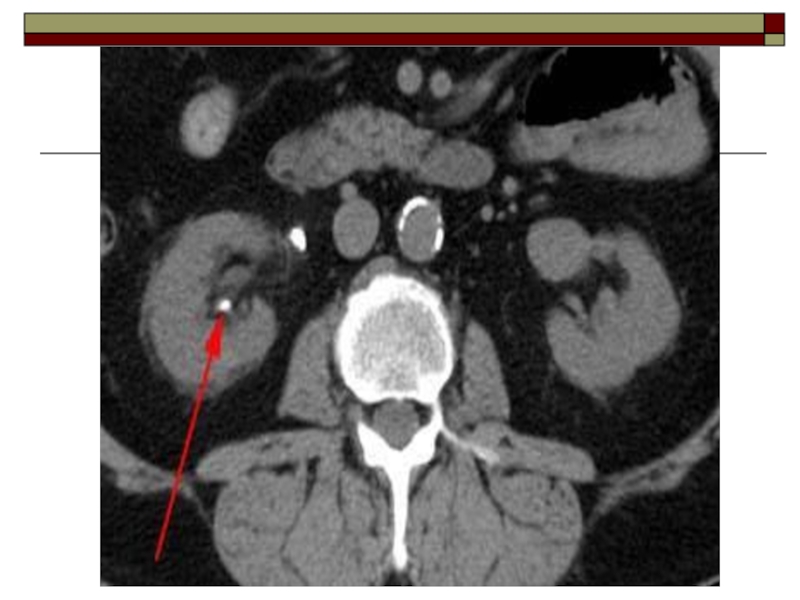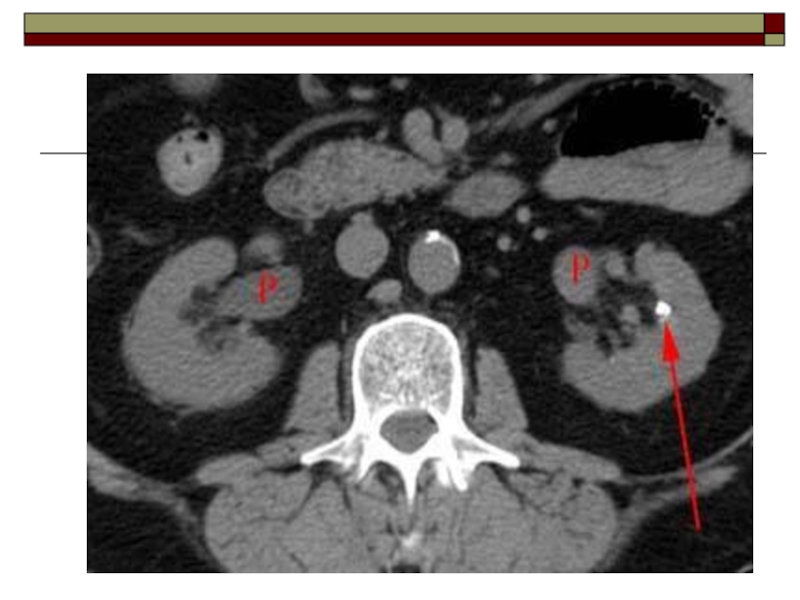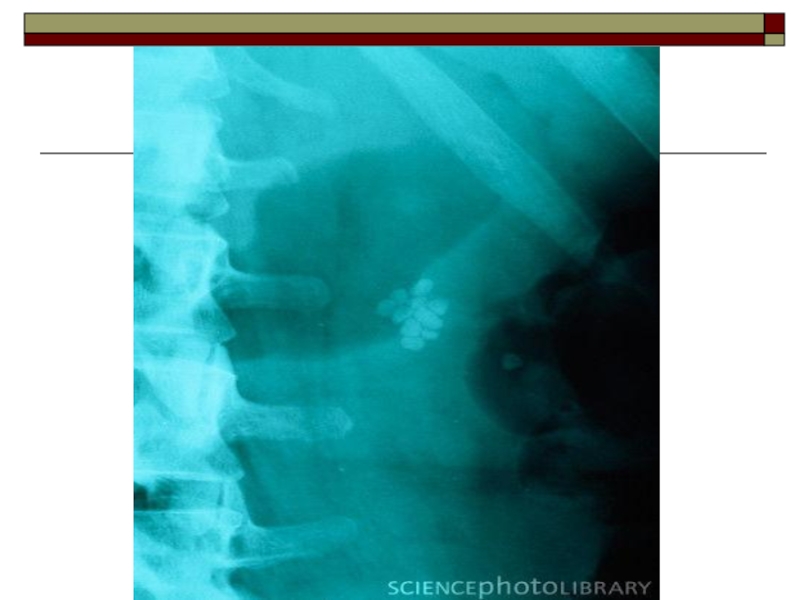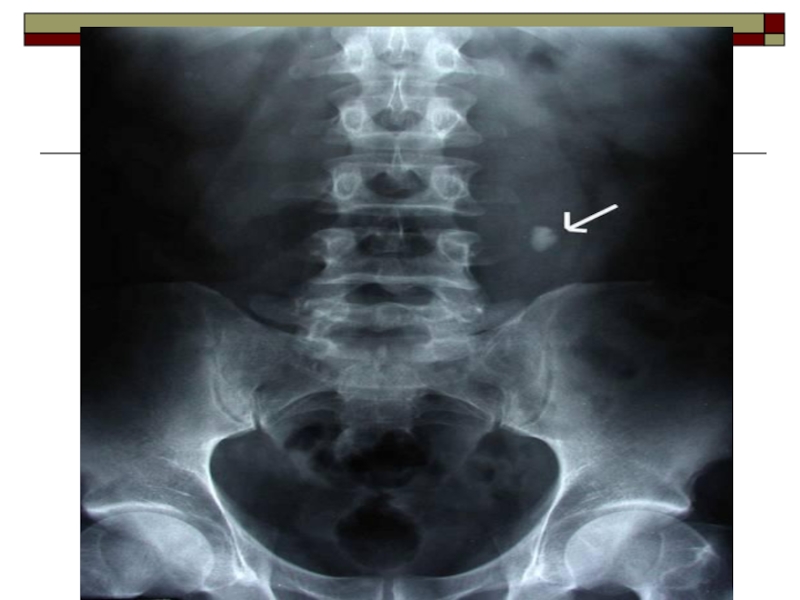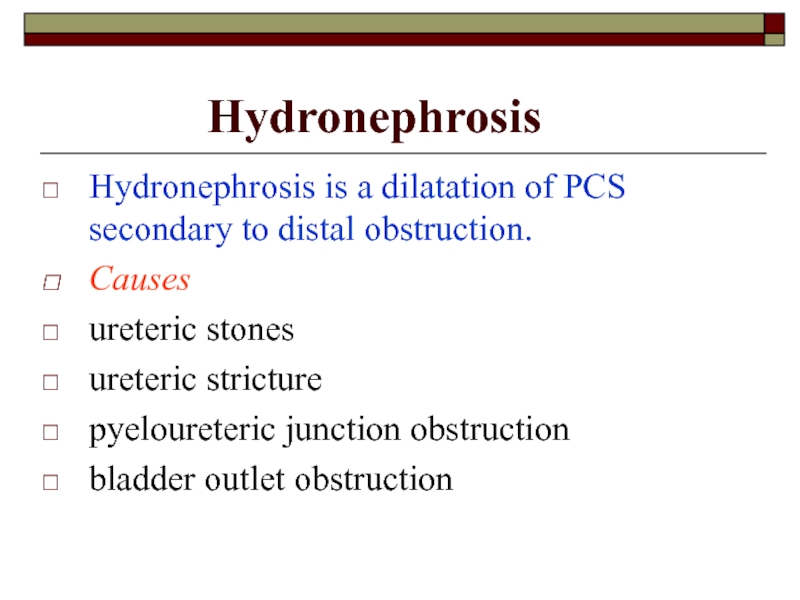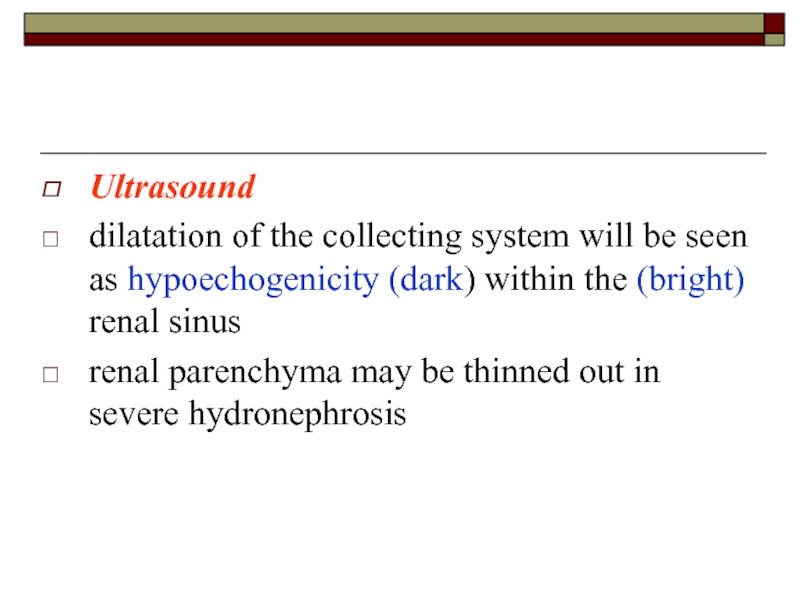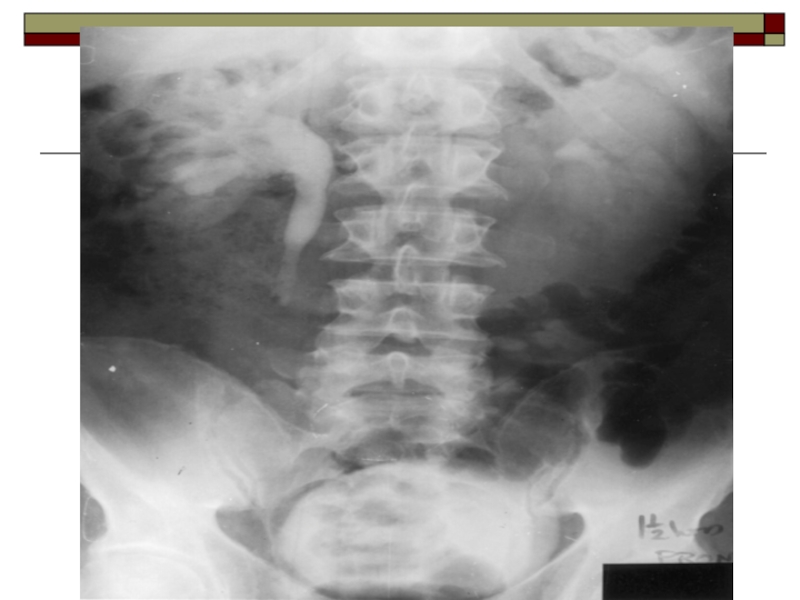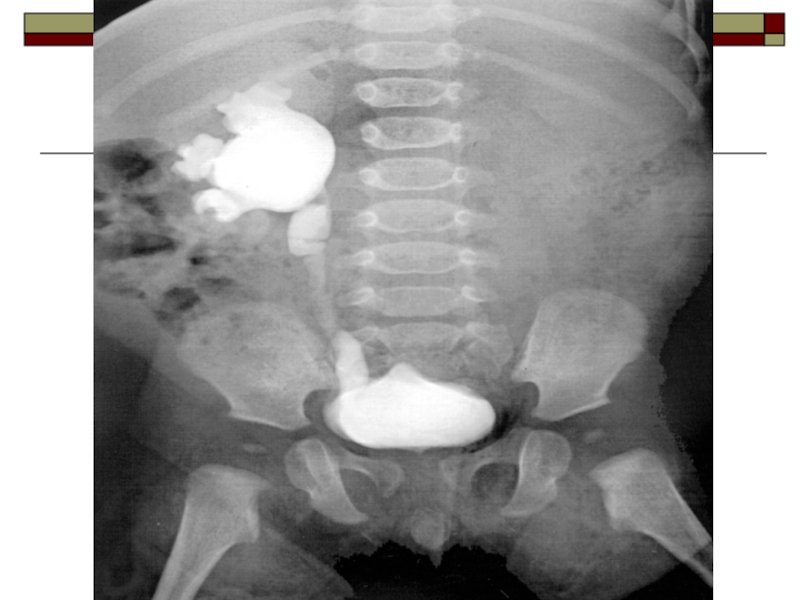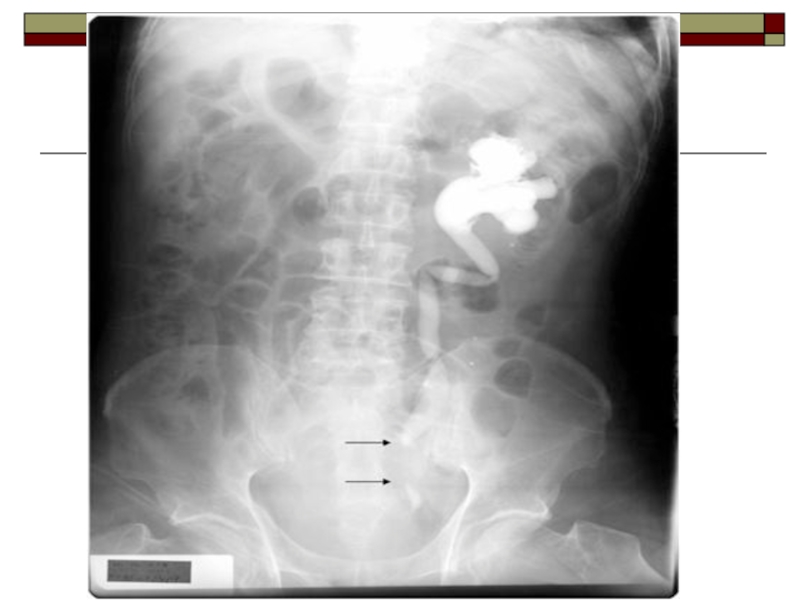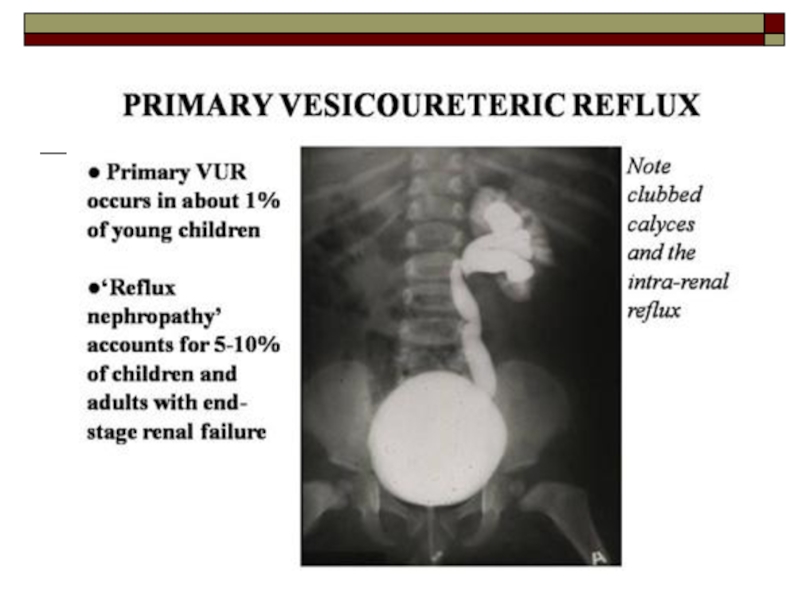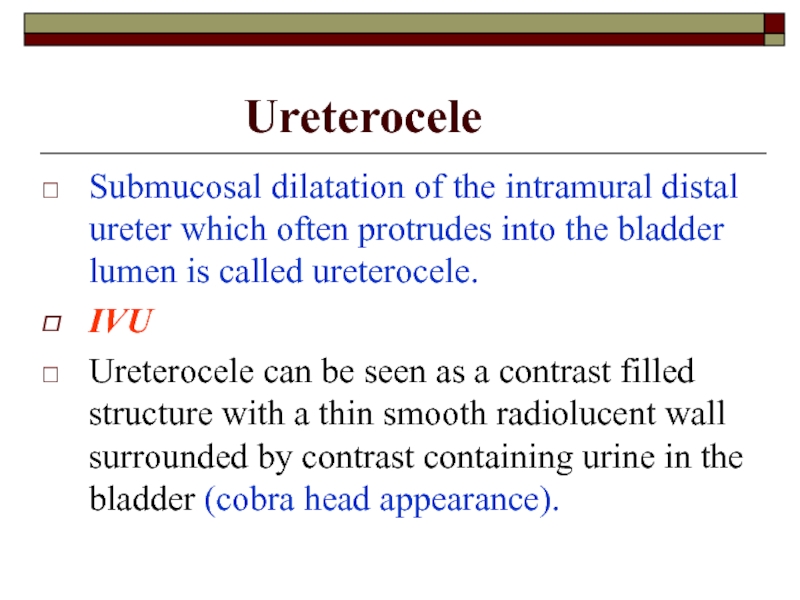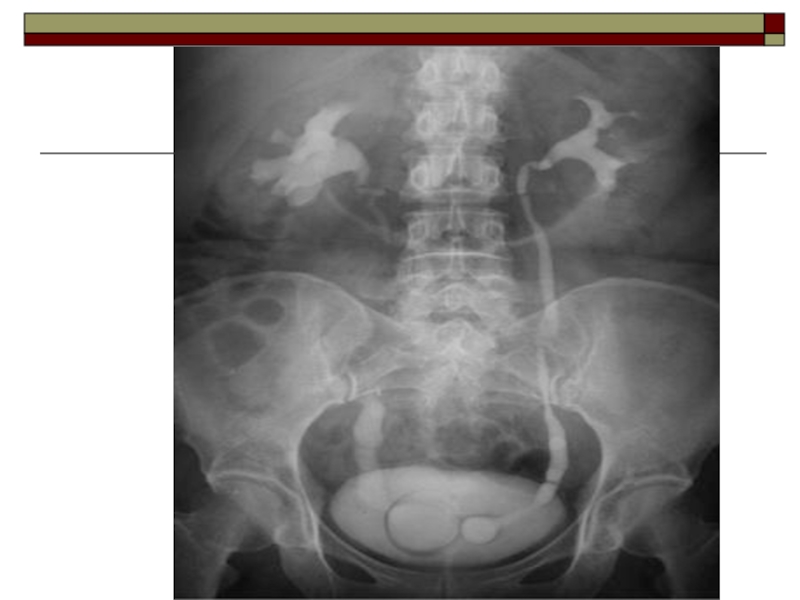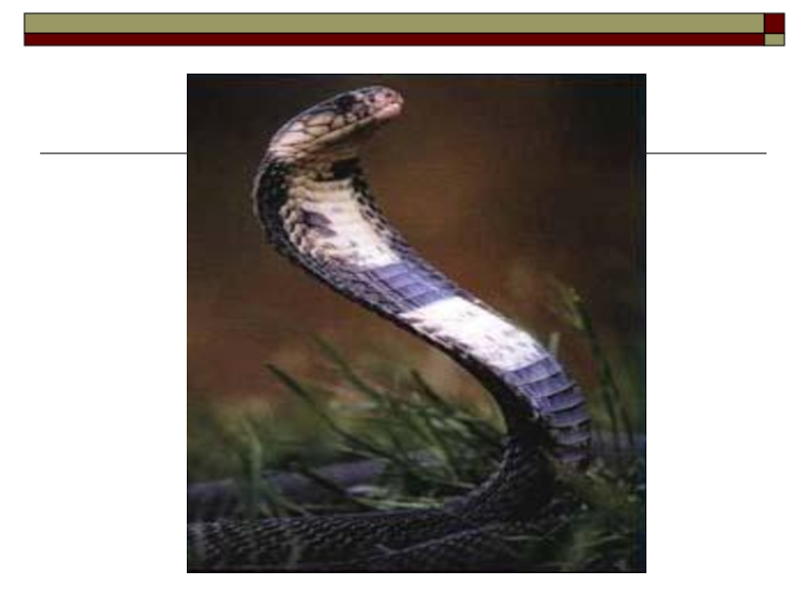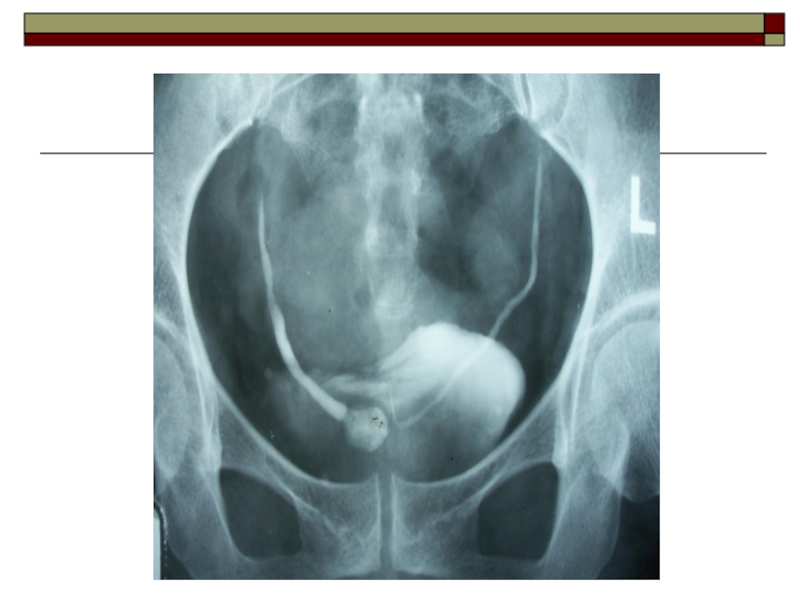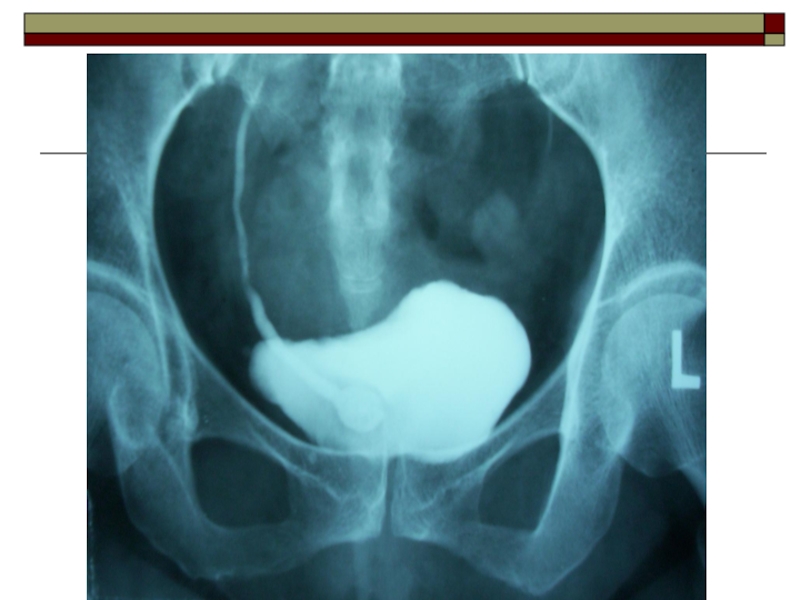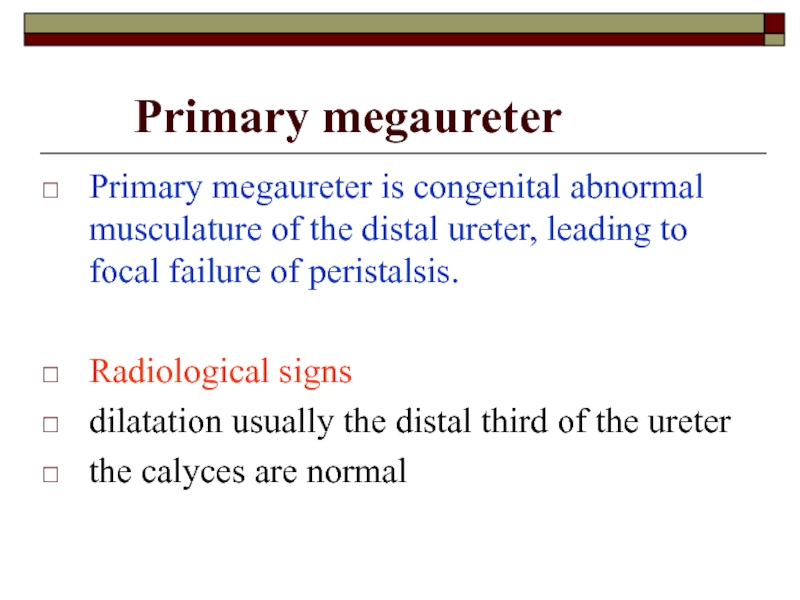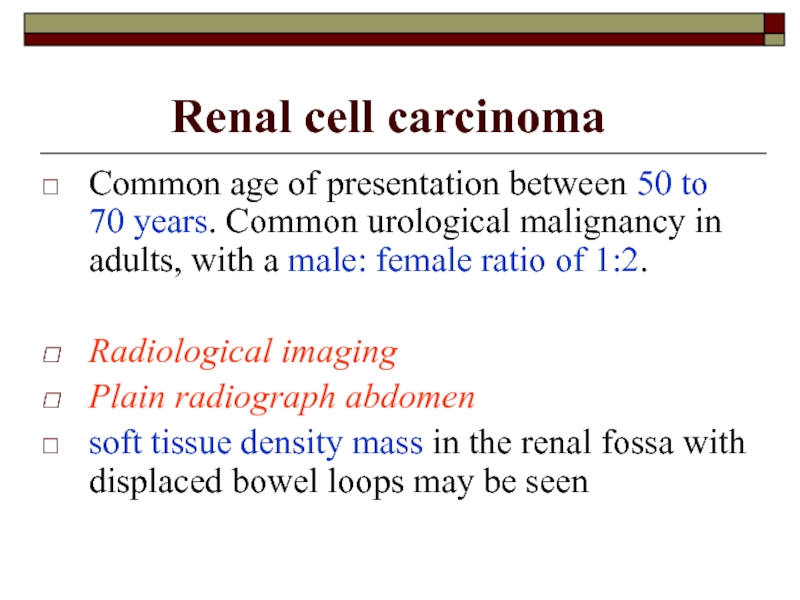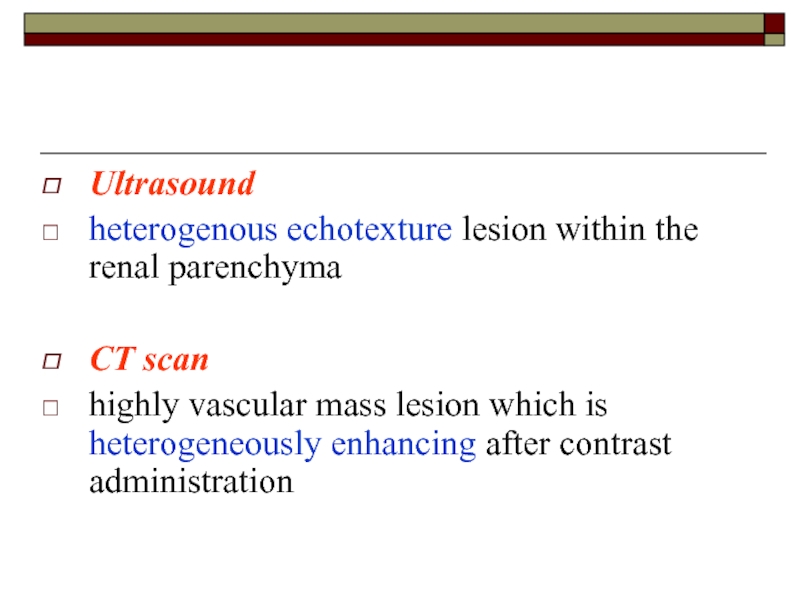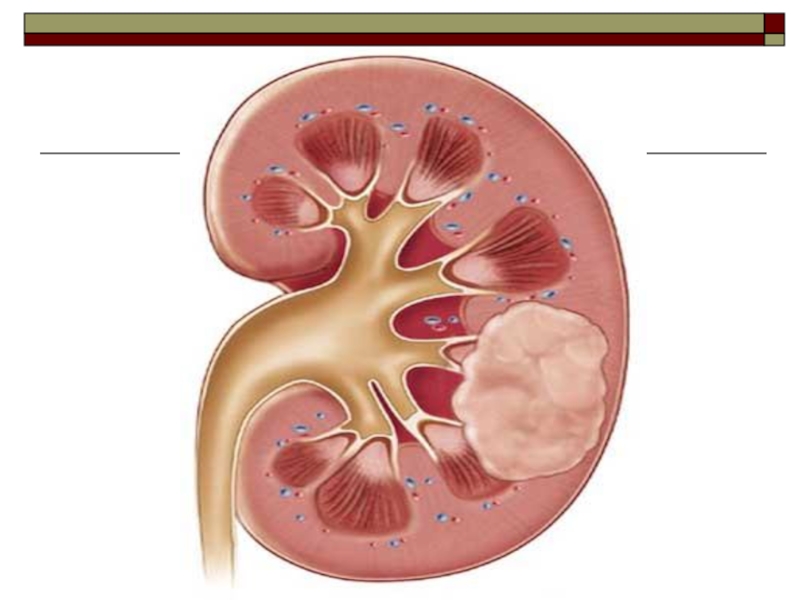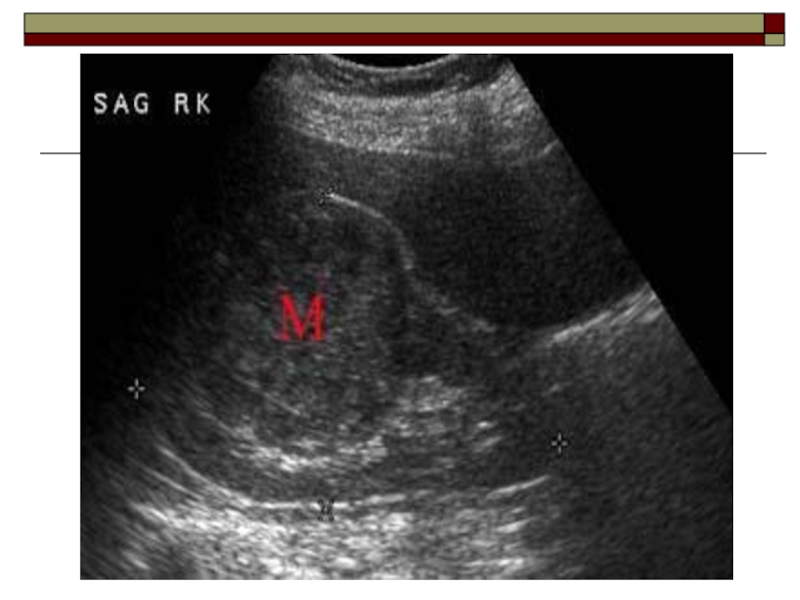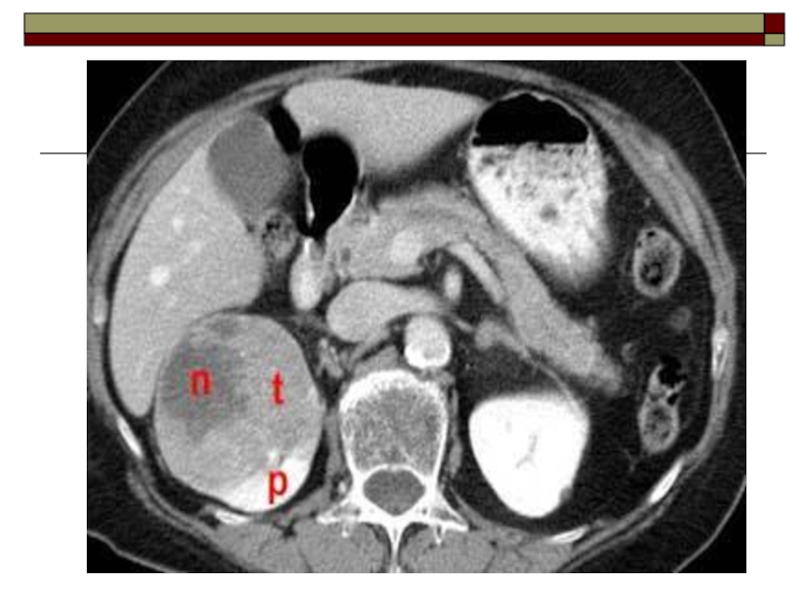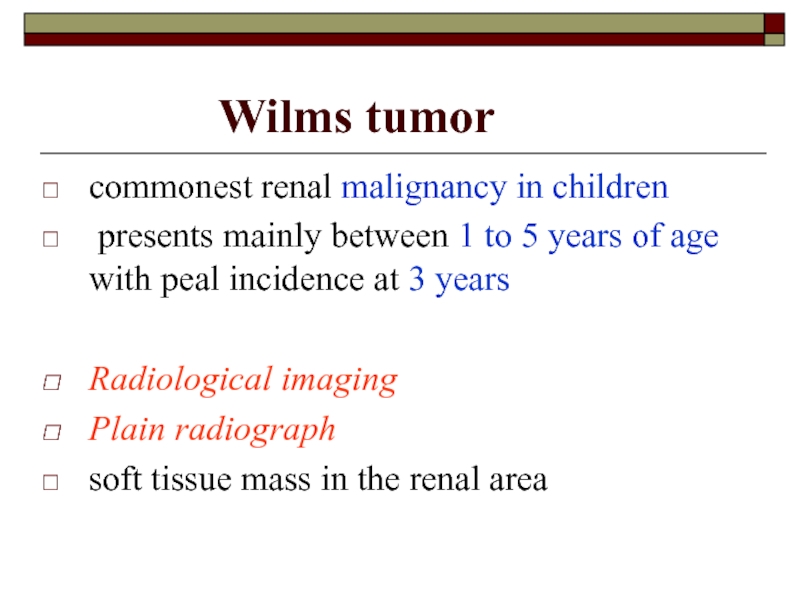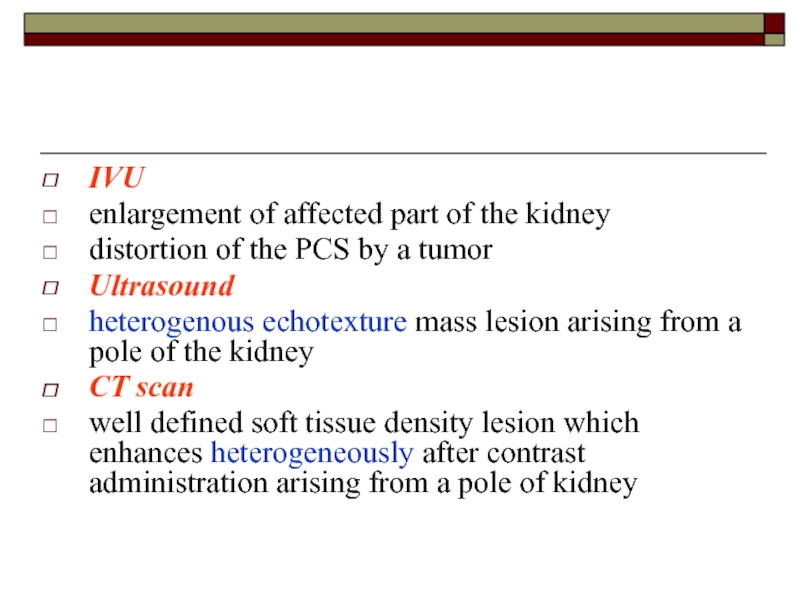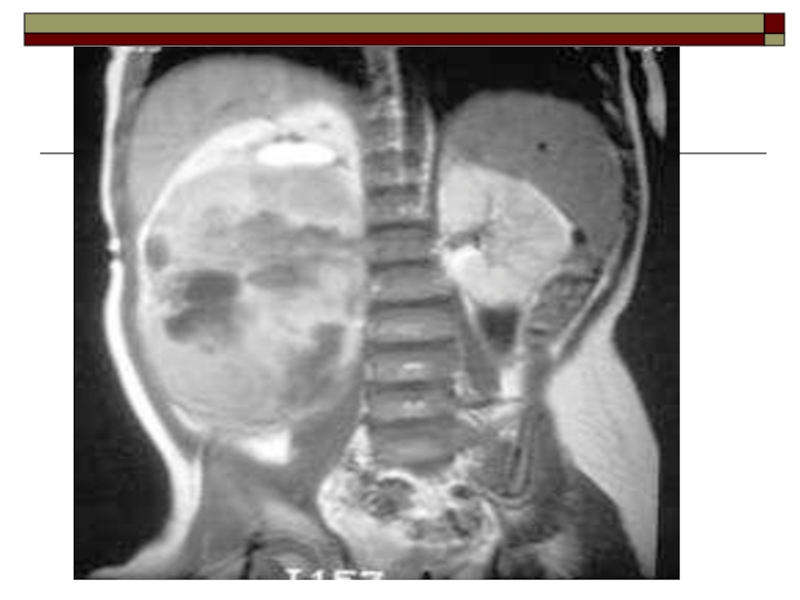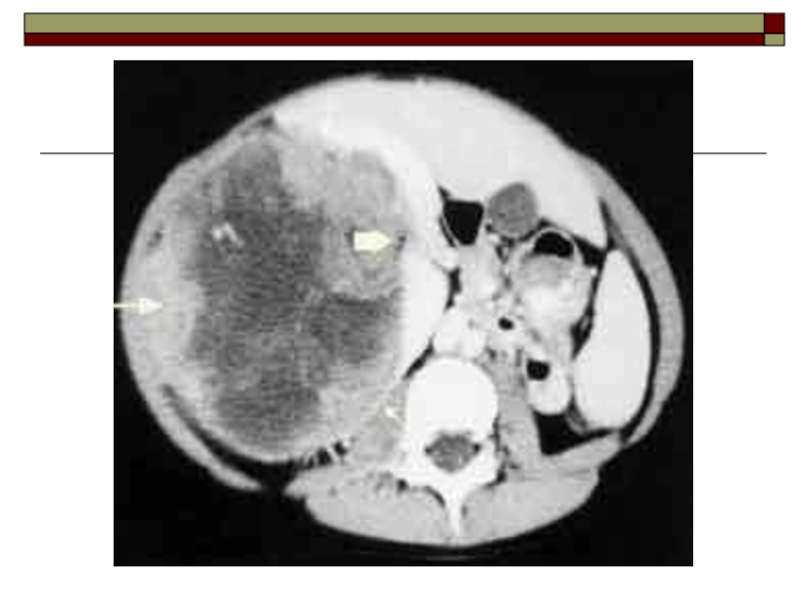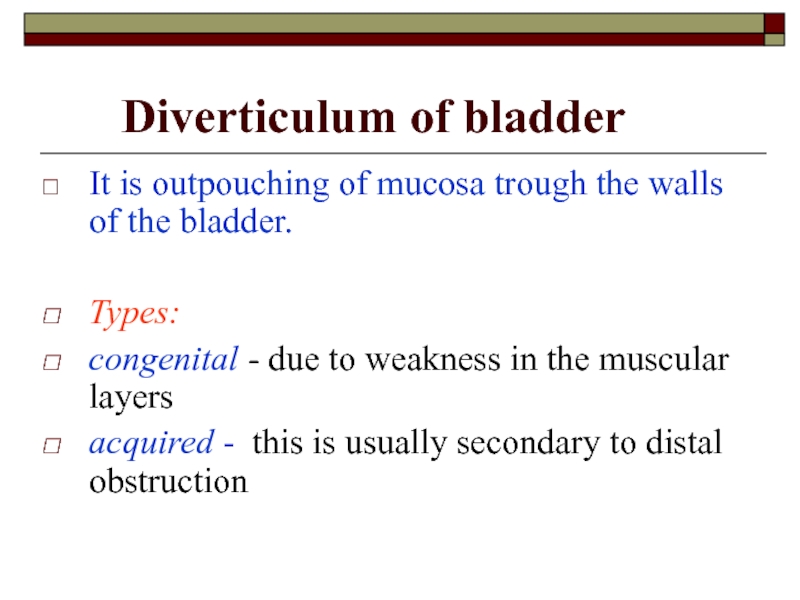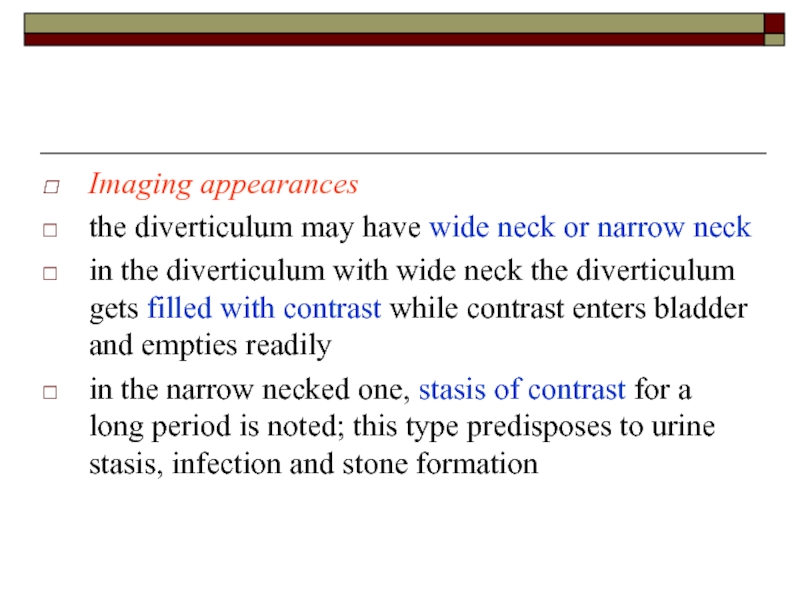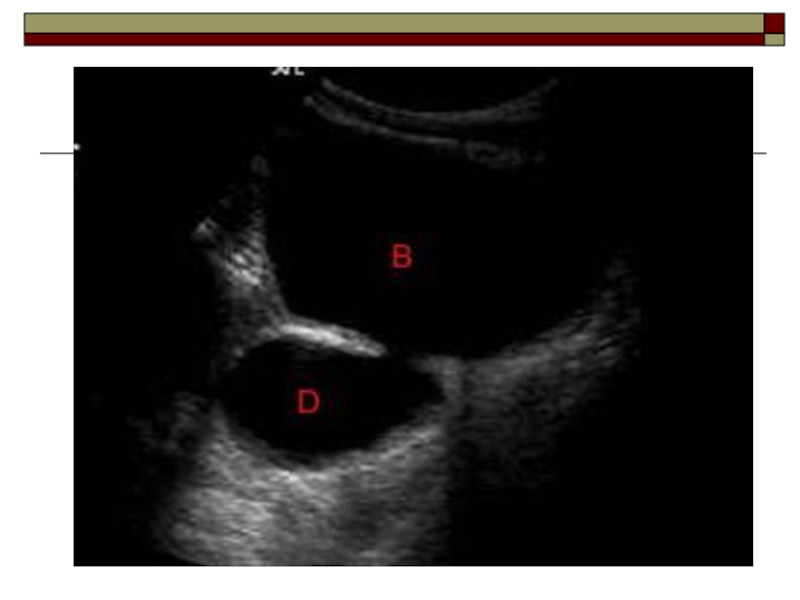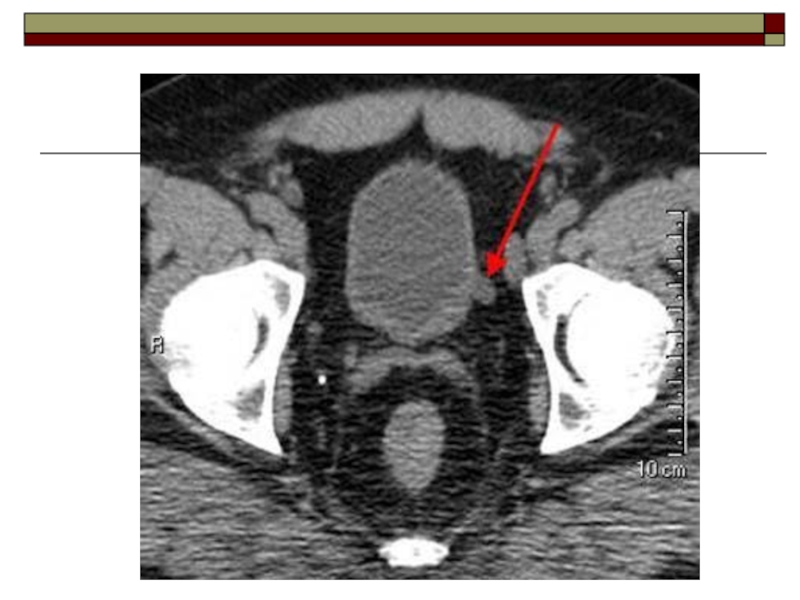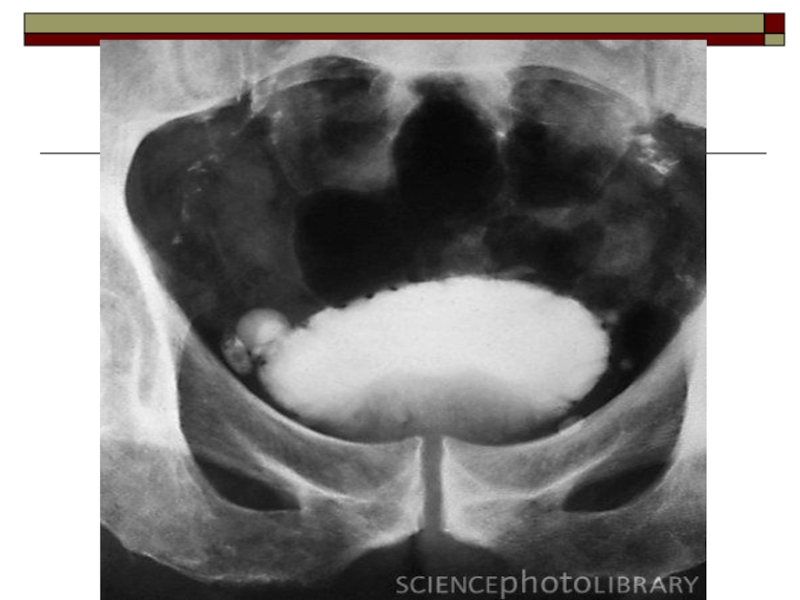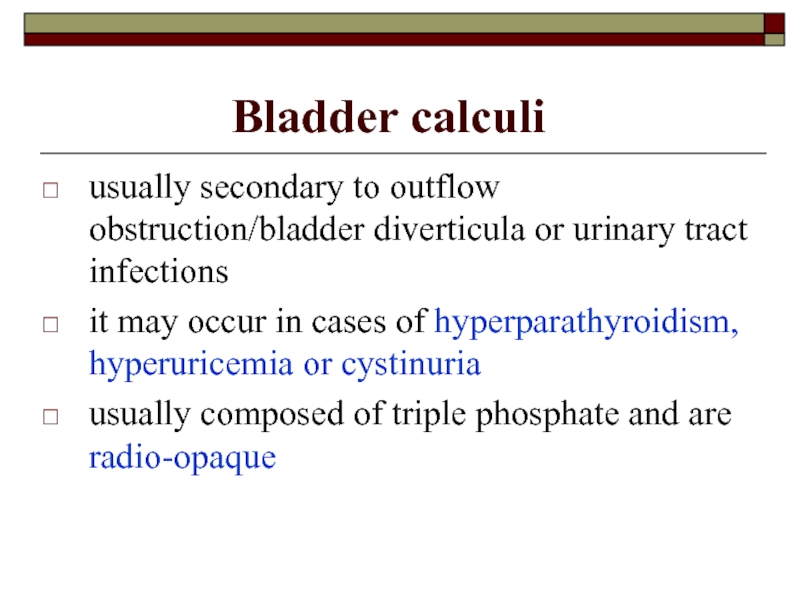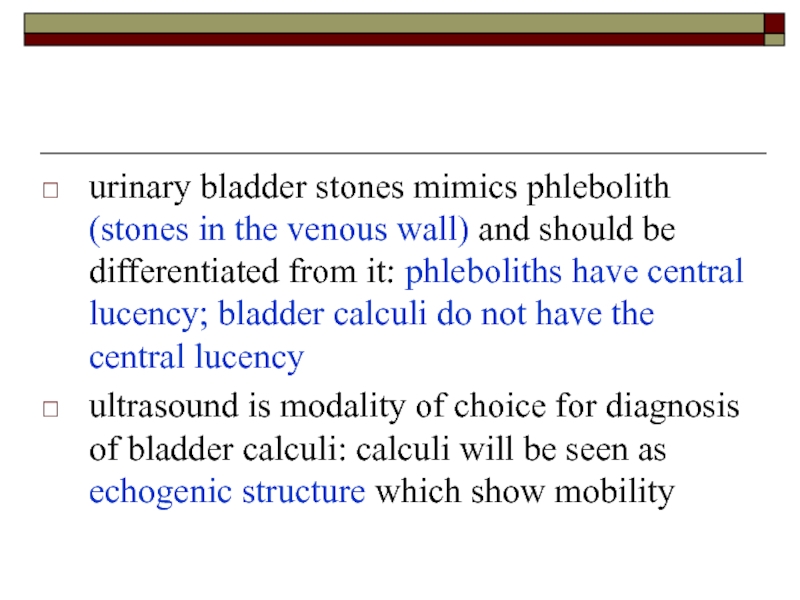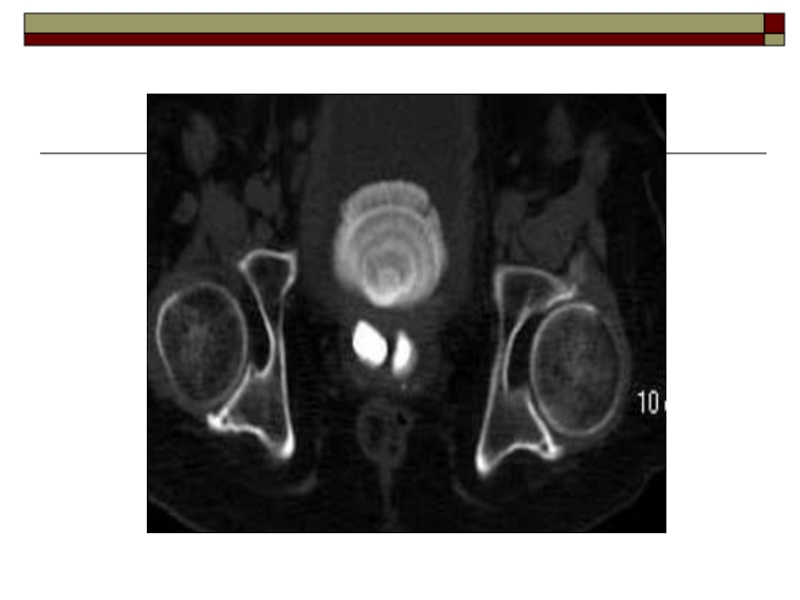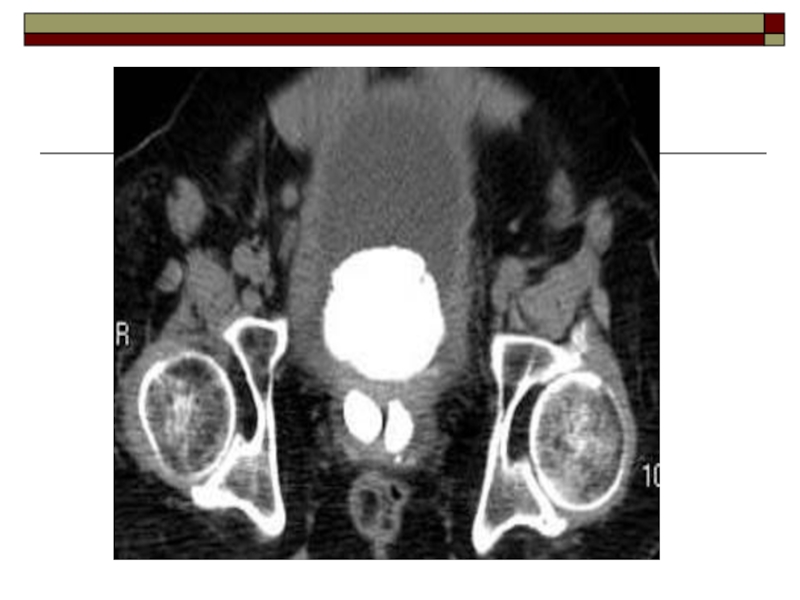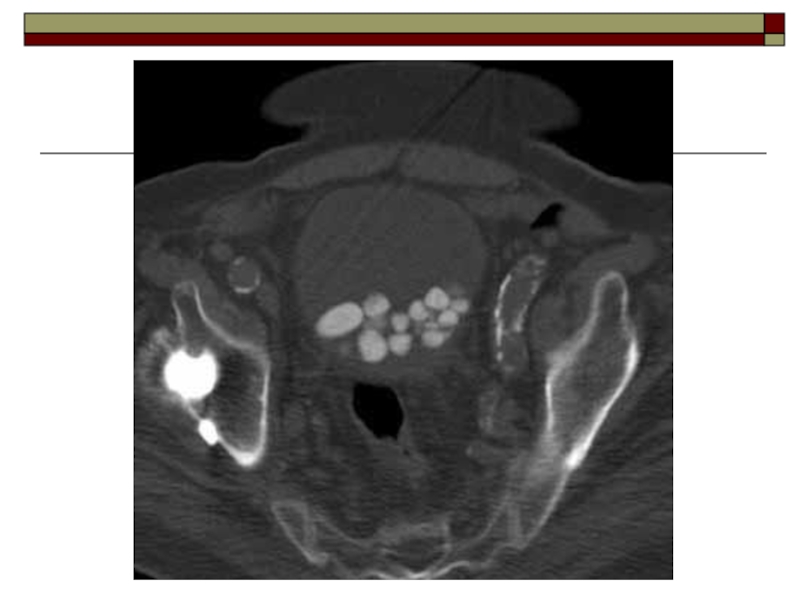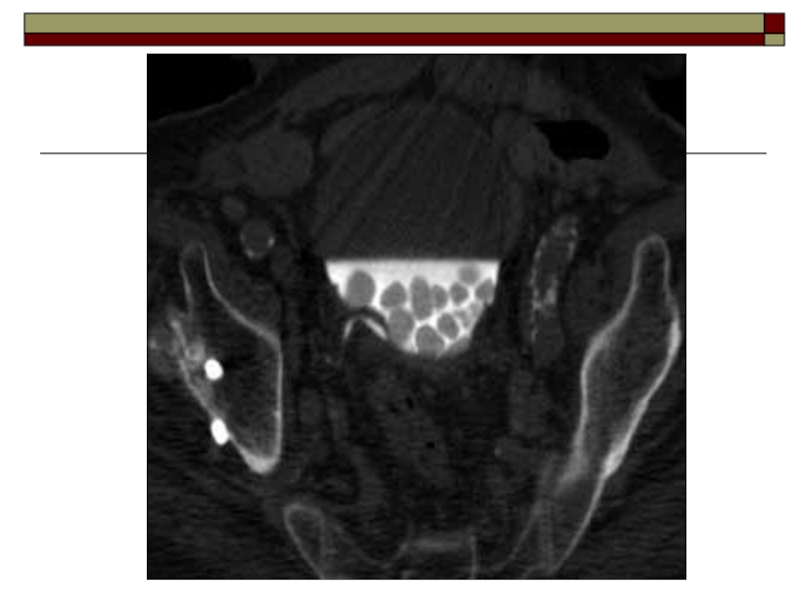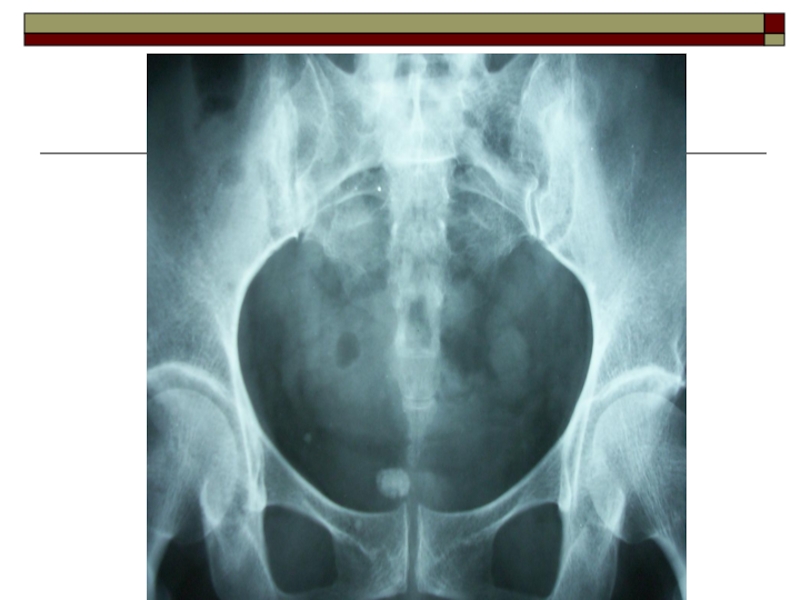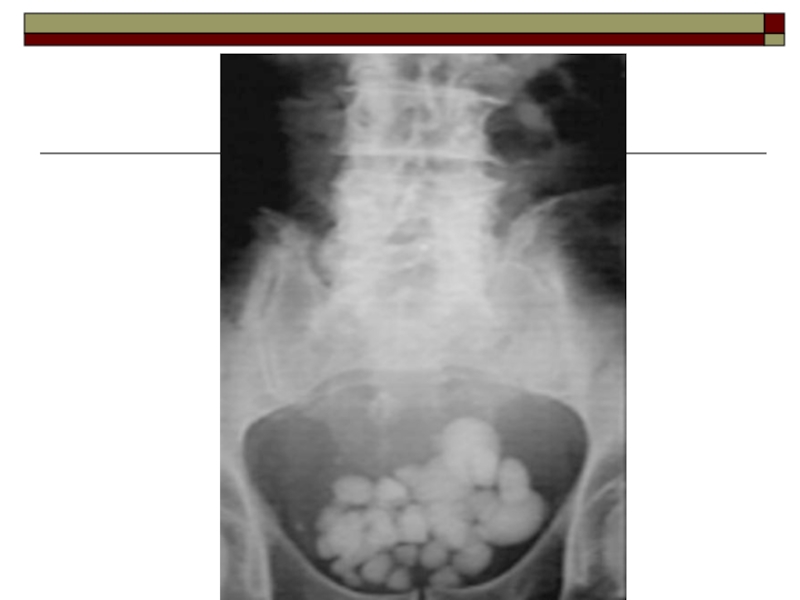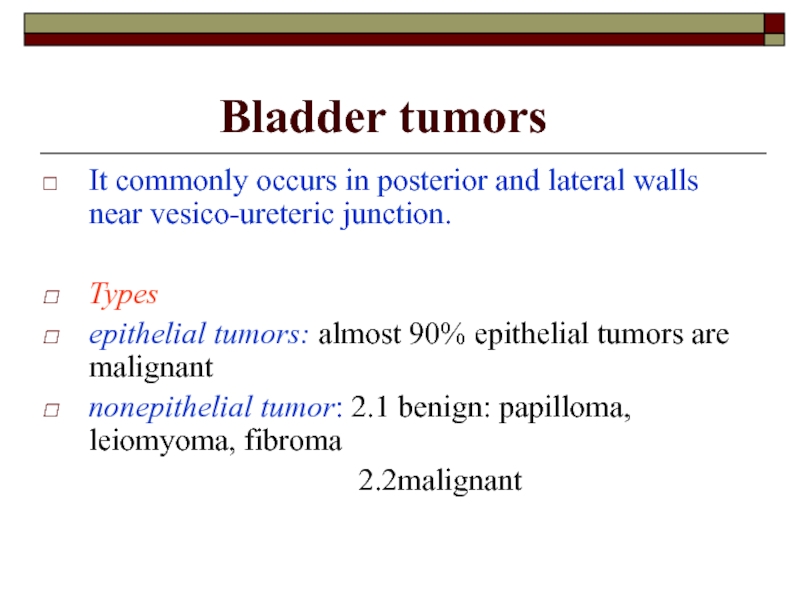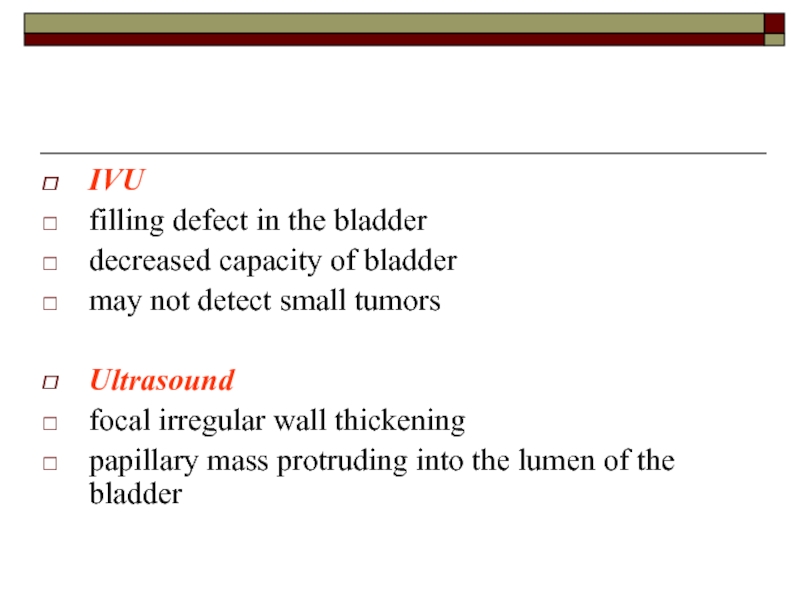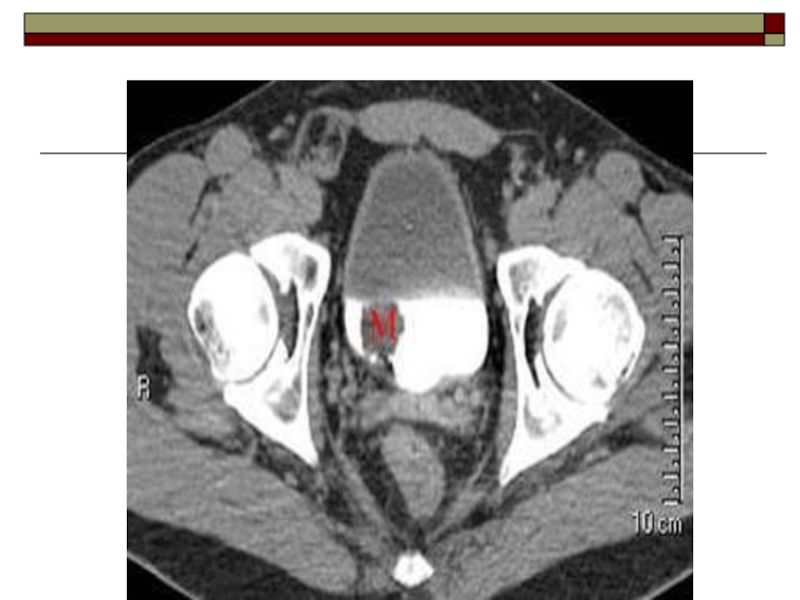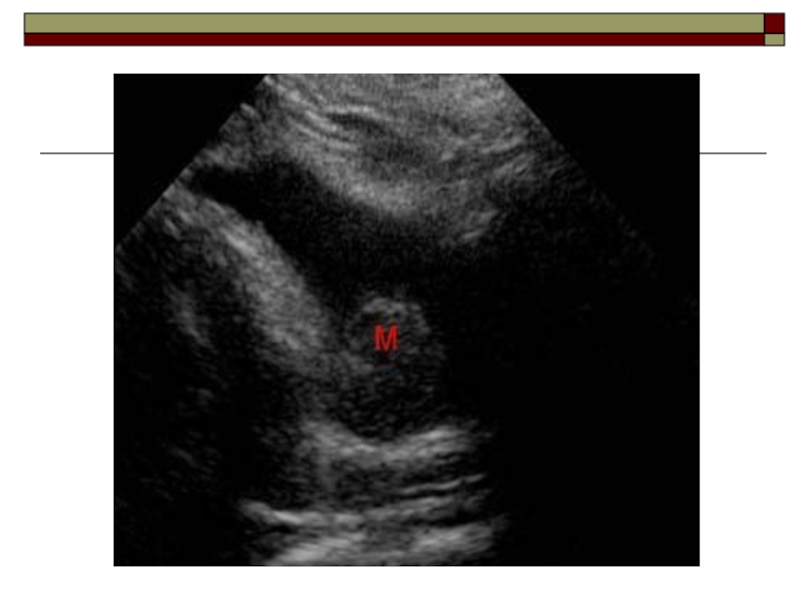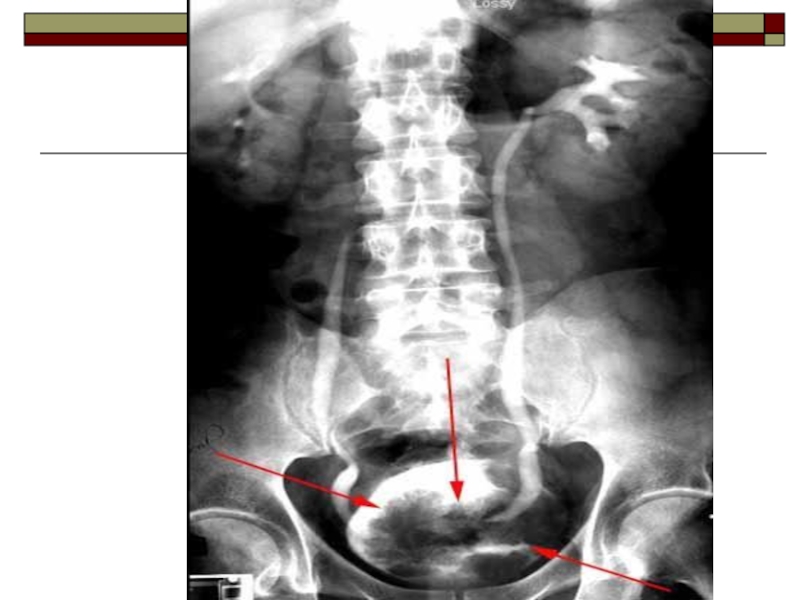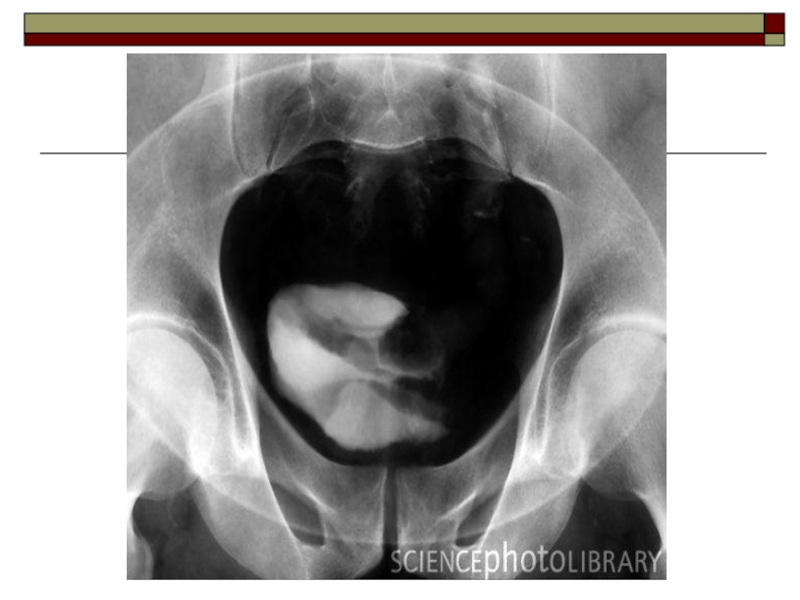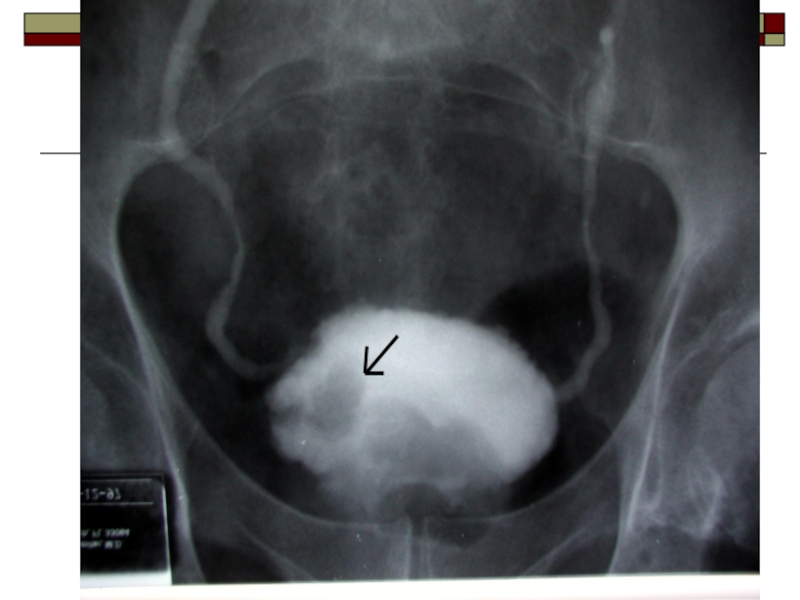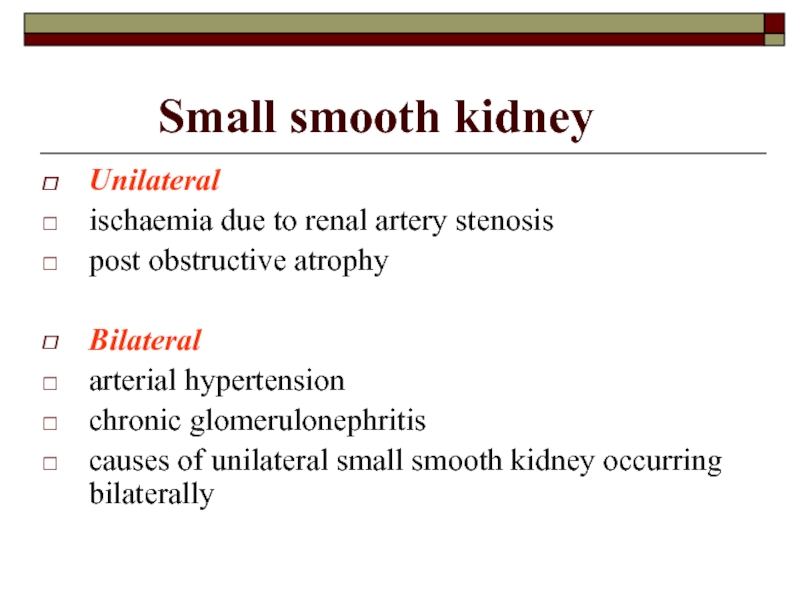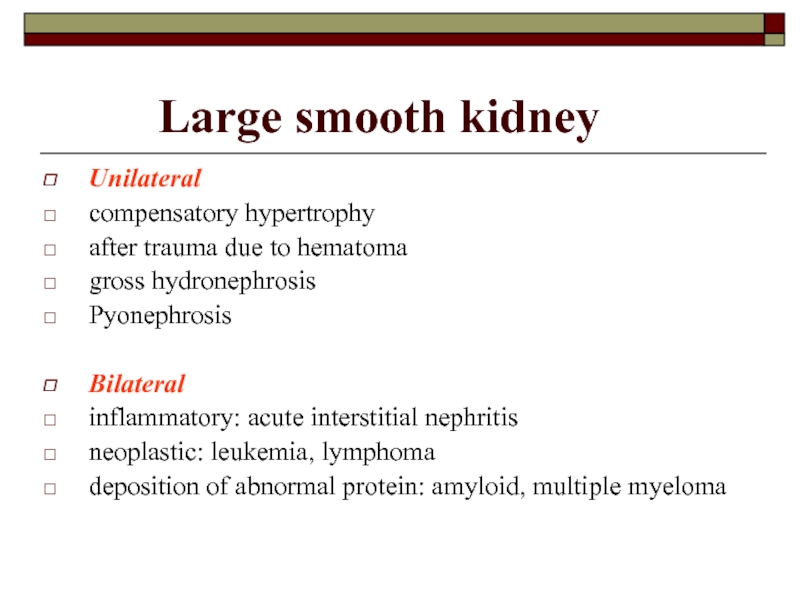- Главная
- Разное
- Дизайн
- Бизнес и предпринимательство
- Аналитика
- Образование
- Развлечения
- Красота и здоровье
- Финансы
- Государство
- Путешествия
- Спорт
- Недвижимость
- Армия
- Графика
- Культурология
- Еда и кулинария
- Лингвистика
- Английский язык
- Астрономия
- Алгебра
- Биология
- География
- Детские презентации
- Информатика
- История
- Литература
- Маркетинг
- Математика
- Медицина
- Менеджмент
- Музыка
- МХК
- Немецкий язык
- ОБЖ
- Обществознание
- Окружающий мир
- Педагогика
- Русский язык
- Технология
- Физика
- Философия
- Химия
- Шаблоны, картинки для презентаций
- Экология
- Экономика
- Юриспруденция
Investigation of the urinary system презентация
Содержание
- 1. Investigation of the urinary system
- 3. This may show renal calculi in
- 4. Caution should be used in interpreting
- 8. Intravenous Urography (IVU): IVU is
- 9. Indications obstructive calculi hematuria or pyuria diseases
- 10. Patient preparation blood urea and serum creatinine
- 11. patient should be well hydrated (dehydrated patients
- 12. Bowel wash is given till bowel is
- 14. Contrast media is injected intravenously into a
- 16. Filming
- 17. 5-10 min film Shows nephrogram, renal pelvis
- 18. 30-35 min film A complete visualization of
- 26. Retrograde pyelography A
- 30. Antegrade pyelography A
- 32. Micturating cystogram A
- 34. Adults: trauma to urethra urethral stricture urethral diverticula vesico-ureteric reflux
- 41. renal obstruction urinary tract infection hematuria congenital
- 42. Urinary bladder
- 44. Dynamic scanning: Technetium-99m DTPA: Isotope clearance
- 47. .
- 50. Computed tomography This
- 54. Congenital anomalies
- 56. Crossed fused ectopia
- 57. Horse
- 58. IVU: may demonstrate the isthmus which connects
- 69. Polycystic kidney disease
- 70. IVU major calyces may be displaced, narrowed
- 71. Ultrasound enlarged kidneys cysts are seen as
- 78. Retrocaval
- 81. Urinary tract
- 82. Radio lucent stones: uric acid stones xanthine
- 83. Ultrasound Stones will be seen as hyperechoic
- 89. IVU Findings may vary with the duration
- 90. Ultrasound dilatation of the collecting system will
- 95. Causes Ureteric calculus Ureteric stricture Ureterocele Congenital megaureter Retroperitoneal tumor/Retroperitoneal fibrosis Pelvic malignancies
- 103. Primary megaureter Primary
- 104. Renal cell
- 105. IVU displacement, compression and cut off of
- 106. Ultrasound heterogenous echotexture lesion within the renal
- 111. IVU enlargement of affected part of the
- 114. Diverticulum of bladder It
- 115. Imaging appearances the diverticulum may have wide
- 121. urinary bladder stones mimics phlebolith (stones in
- 129. Epithelial tumors: 90%-transitional cell ca 1-10%-squamous cell ca Clinical features painless hematuria Imaging
- 130. IVU filling defect in the bladder decreased
- 136. Small smooth
- 137. Large smooth
Слайд 2 Plain Film:
Plain film
A plain abdominal film is essential prior to urinary tract investigation.
Слайд 3This may show
renal calculi in the pelvicalyceal system
renal parenchymal
ureteric calculi
bladder calcification and calculi
prostatic calcification or sclerotic bone deposits
Слайд 4 Caution should be used in interpreting renal-tract calcification as overlying
Слайд 8 Intravenous Urography (IVU):
IVU is frequently performed in the evaluation
Слайд 9Indications
obstructive calculi
hematuria or pyuria
diseases of renal collecting system and renal pelvis
abnormalities
tuberculosis of the urinary tract
prior to endourological procedures and surgery of the urinary tract
suspected renal injury
renal colic or flank pain
in children – polycystic kidney diseases, pelvi-ureteric junction obstruction, anorectal anomalies
pelvic malignancies to see uretic involvement
Слайд 10Patient preparation
blood urea and serum creatinine level should be within normal
if patient is asthmatic premedication in the form of steroids is administered two days prior
fasting after 10 pm (previous night) (as contrast injection sometimes induces nausea which might lead to vomiting and aspiration)
Слайд 11patient should be well hydrated (dehydrated patients are prone for renal
bowel preparation is necessary, as gas and faecal matter filled bowel loops will obscure the kidney shadows
low residue diet with plenty of oral fluids, the day previous to the IVU
Слайд 12Bowel wash is given till bowel is clear of faecal matter
Laxatives (ducolax, castor oil) are recommended to eliminate faecal matter from colon and gas absorbing agents (flatulex) are given to reduce the amount of gas in the bowel.
In young children no special preparation is needed, only 4 hours fasting is sufficient.
Слайд 13 Procedure
Patient is
A plain film is taken which includes the kidneys, ureters, bladder and urethral regions on a large size film, called as the scout film.
Слайд 14Contrast media is injected intravenously into a prominent vein in the
The dose of contrast media is 2 ml/kg body wt.
Слайд 15 Contrast media
Contrast materials
They are two types:
ionic (urograffin, angiograffin)
non-ionic (omnipaque, ultravist)
Ionic contrast media have a higher incidence of reaction but they are cheaper as compared to the non-ionic contrast media.
Слайд 16 Filming technique and
Plain x-ray (scout film)
It gives information about:
renal outlines
psoas muscles
bony structures such as vertebra and its appendages, pelvis
any stones
abdominal mass
foreign body
Слайд 175-10 min film
Shows nephrogram, renal pelvis
15-20 min film
A complete visualization of
Слайд 1830-35 min film
A complete visualization of the urinary tract: kidney, ureter,
The series is varied according to the individual patient. Renal obstruction may require a delayed study up to 24 hours to outline the pelvicalyceal system.
Слайд 19 Post void
It taken immediately after voiding.
To assess for:
residual urine
bladder mucosal lesions
diverticula
bladder tumors
outlet obstruction
Слайд 26 Retrograde pyelography
A retrograde pyelography is occasionally necessary
A catheter is placed into the ureter after a cystoscopy; contrast injected trough the catheter outlines the pelvicalyceal system and ureter.
Слайд 30 Antegrade pyelography
A fine-gauge needle, under local anesthetic,
Слайд 32 Micturating cystogram
A catheter is inserted in the
Слайд 33 Indications
Children:
vesico-ureteric
post urinary tract infection
trauma
hematuria
posterior urethral valve
voiding difficulties like dysuria, thin stream, frequency and urgency
in case of genitor-urinary anomalies
Слайд 36 Urethrography
The adult male urethra
ascending urethrography: contrast is injected into the meatus and films obtained of the urethra
descending urethrography: after filling the bladder with contrast, the catheter is removed and films of the urethra are taken during micturition
In both studies, the entire urethra must be studied.
Слайд 40 Ultrasound
Ultrasound is
It is extremely effective in evaluating:
renal size
growth
masses
Слайд 41renal obstruction
urinary tract infection
hematuria
congenital abnormalities
renal failure
transplants
bladder residual volumes
prostatic size
it is non-invasive
Слайд 43 Isotope Scanning:
Static Scanning: Technetium-99m
Selective uptake by the renal cells with stagnation in the proximal tubules produces images of the renal parenchyma. The isotope is used to assess function, position, size and scarring of kidneys.
Слайд 44Dynamic scanning: Technetium-99m DTPA:
Isotope clearance by glomerular filtration produces a
Слайд 47.
Arteriography:
Evaluation of
further investigation of equivocal renal masses: renal cell carcinoma are usually hypervascular with a pathological circulation
arteriovenous malformation
renal artery stenosis
anatomical details prior to renal transplantation
suspected vascular occlusion after surgery
Слайд 50 Computed tomography
This aids assessment of:
renal masses –
obstruction
retroperitoneal disease
staging of renal and bladder neoplasm
tumor invasion into the renal vein or inferior vena cava
evaluation after trauma, surgery or chemotherapy
inflammation
trauma
Слайд 54 Congenital anomalies
Ectopic kidney
Normally the kidneys are
pelvic
sacrum
lower lumbar levels
intrathoracic kidneys – commonly occurs on left side of thorax
Слайд 56 Crossed fused ectopia
The two renal masses fuse
Слайд 57 Horse shoe kidney
Is a fusion
Plain radiograph: the axis of each kidney is markedly altered, the upper pole being more lateral and the lower pole being more medial.
Слайд 58IVU: may demonstrate the isthmus which connects the two kidneys. There
CT shows: the parenchyma of the horseshoe kidney is well visualized. Isthmus can be very well depicted in CT.
Слайд 63 Duplex Kidney:
the commonest
Слайд 69 Polycystic kidney disease
Clinical features
hypertension
bilaterally enlargement kidneys as
loin pain rarely
Plain film
enlargement kidneys seen as soft tissue masses bilaterally
occasionally dystrophic calcification in cyst seen
Слайд 70IVU
major calyces may be displaced, narrowed and elongated by adjacent cyst
in
also large doses of contrast will be needed for opacification of the pelvicalyceal system
Слайд 71Ultrasound
enlarged kidneys
cysts are seen as anechoic lesions (black) with distal acoustic
CT
cysts will be seen as multiple hypodense lesions with density of fluid
Слайд 78 Retrocaval ureter
Normally the right ureter
Occasionally the right ureter takes an aberrant course running sharply medially and behind the inferior vena cava and then courses anterior to the vena cava and then drops inferiorly into the pelvis.
It may be associated with hydronephrosis due to its abnormal course.
Слайд 81 Urinary tract stones
Urinary tract stones are
Radio opaque stones:
calcium oxalate and phosphate stones
cysteine stones – they contain sulphur
struvite stones: this consists of magnesium ammonium phosphate
Слайд 82Radio lucent stones:
uric acid stones
xanthine stones
Radiolucent stones are not visualized on
Слайд 83Ultrasound
Stones will be seen as hyperechoic (bright) focus within the collecting
Ultrasound is especially important in detecting radiolucent stones not seen in IVU and plain x-ray.
Ct scan
No enhanced CT scan is the modality of choice for diagnosis calculus.
Advantages:
detection of multiple stones
other causes of abdominal pain which may mimic renal colic
Слайд 88 Hydronephrosis
Hydronephrosis is a dilatation
Causes
ureteric stones
ureteric stricture
pyeloureteric junction obstruction
bladder outlet obstruction
Слайд 89IVU
Findings may vary with the duration and degree of the obstruction.
Crading
Grade1: minimal blunting of forniceal angle
Grade2: blunting of calyces with intact papillary markings
Grade3: loss of papillary markings
Grade4: ballooning of the calyces
Слайд 90Ultrasound
dilatation of the collecting system will be seen as hypoechogenicity (dark)
renal parenchyma may be thinned out in severe hydronephrosis
Слайд 94 Hydroureter
Hydroureter is
An absolute ureteral diameter exceeding 8 mm is considered by some authors to represent a criterion for dilatation. In general, asymmetry of ureteral caliber is a more significant findings.
Early in its course, high-grade ureteral obstruction may be associated with only minimal ureteral dilatation. More chronic forms of obstruction and other chronic ureteral conditions are typically associated with greater degrees of ureteral dilatation.
No obstructive dilatation may occur as a result of high urine flow, reflux, or inflammatory processes.
Слайд 95Causes
Ureteric calculus
Ureteric stricture
Ureterocele
Congenital megaureter
Retroperitoneal tumor/Retroperitoneal fibrosis
Pelvic malignancies
Слайд 98 Ureterocele
Submucosal dilatation of
IVU
Ureterocele can be seen as a contrast filled structure with a thin smooth radiolucent wall surrounded by contrast containing urine in the bladder (cobra head appearance).
Слайд 103 Primary megaureter
Primary megaureter is congenital abnormal musculature
Radiological signs
dilatation usually the distal third of the ureter
the calyces are normal
Слайд 104 Renal cell carcinoma
Common age of presentation
Radiological imaging
Plain radiograph abdomen
soft tissue density mass in the renal fossa with displaced bowel loops may be seen
Слайд 105IVU
displacement, compression and cut off of calyces, change of axis of
enlargement of affected part of kidney with focal bulge in renal contour
large tumor may displace entire kidney across midline
upper pole tumor may cause caudal displacement of calyces
large tumor mass obstructing the renal pelvis may cause hydronephrosis
Слайд 106Ultrasound
heterogenous echotexture lesion within the renal parenchyma
CT scan
highly vascular mass lesion
Слайд 110 Wilms tumor
commonest renal malignancy
presents mainly between 1 to 5 years of age with peal incidence at 3 years
Radiological imaging
Plain radiograph
soft tissue mass in the renal area
Слайд 111IVU
enlargement of affected part of the kidney
distortion of the PCS by
Ultrasound
heterogenous echotexture mass lesion arising from a pole of the kidney
CT scan
well defined soft tissue density lesion which enhances heterogeneously after contrast administration arising from a pole of kidney
Слайд 114 Diverticulum of bladder
It is outpouching of mucosa trough
Types:
congenital - due to weakness in the muscular layers
acquired - this is usually secondary to distal obstruction
Слайд 115Imaging appearances
the diverticulum may have wide neck or narrow neck
in the
in the narrow necked one, stasis of contrast for a long period is noted; this type predisposes to urine stasis, infection and stone formation
Слайд 120 Bladder calculi
usually secondary
it may occur in cases of hyperparathyroidism, hyperuricemia or cystinuria
usually composed of triple phosphate and are radio-opaque
Слайд 121urinary bladder stones mimics phlebolith (stones in the venous wall) and
ultrasound is modality of choice for diagnosis of bladder calculi: calculi will be seen as echogenic structure which show mobility
Слайд 128 Bladder tumors
It commonly occurs
Types
epithelial tumors: almost 90% epithelial tumors are malignant
nonepithelial tumor: 2.1 benign: papilloma, leiomyoma, fibroma
2.2malignant
Слайд 129Epithelial tumors:
90%-transitional cell ca
1-10%-squamous cell ca
Clinical features
painless hematuria
Imaging
Слайд 130IVU
filling defect in the bladder
decreased capacity of bladder
may not detect small
Ultrasound
focal irregular wall thickening
papillary mass protruding into the lumen of the bladder
Слайд 136 Small smooth kidney
Unilateral
ischaemia due to renal
post obstructive atrophy
Bilateral
arterial hypertension
chronic glomerulonephritis
causes of unilateral small smooth kidney occurring bilaterally
Слайд 137 Large smooth kidney
Unilateral
compensatory hypertrophy
after trauma due
gross hydronephrosis
Pyonephrosis
Bilateral
inflammatory: acute interstitial nephritis
neoplastic: leukemia, lymphoma
deposition of abnormal protein: amyloid, multiple myeloma
